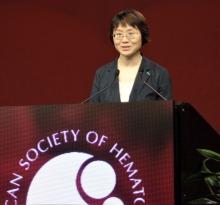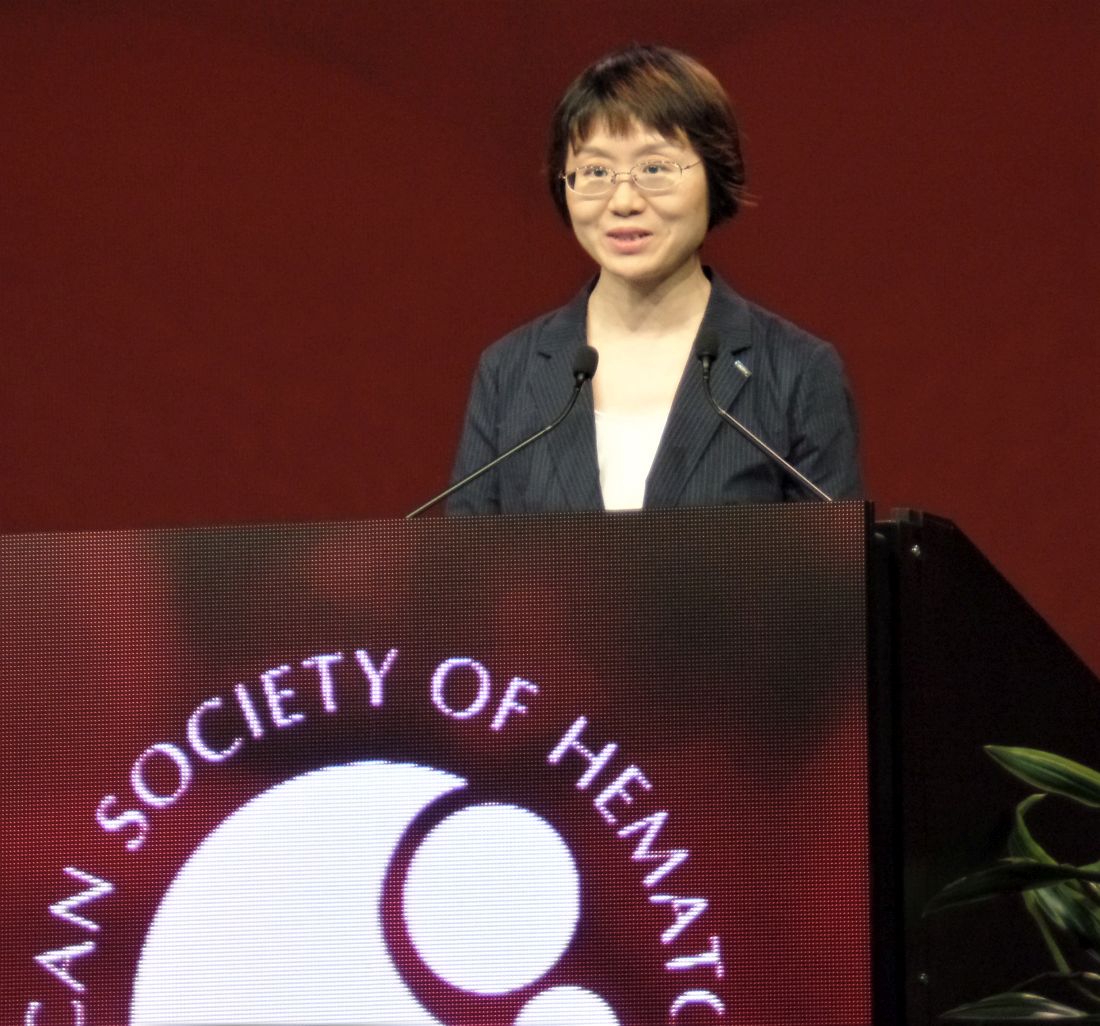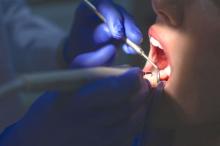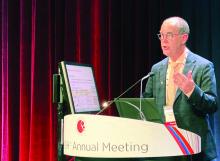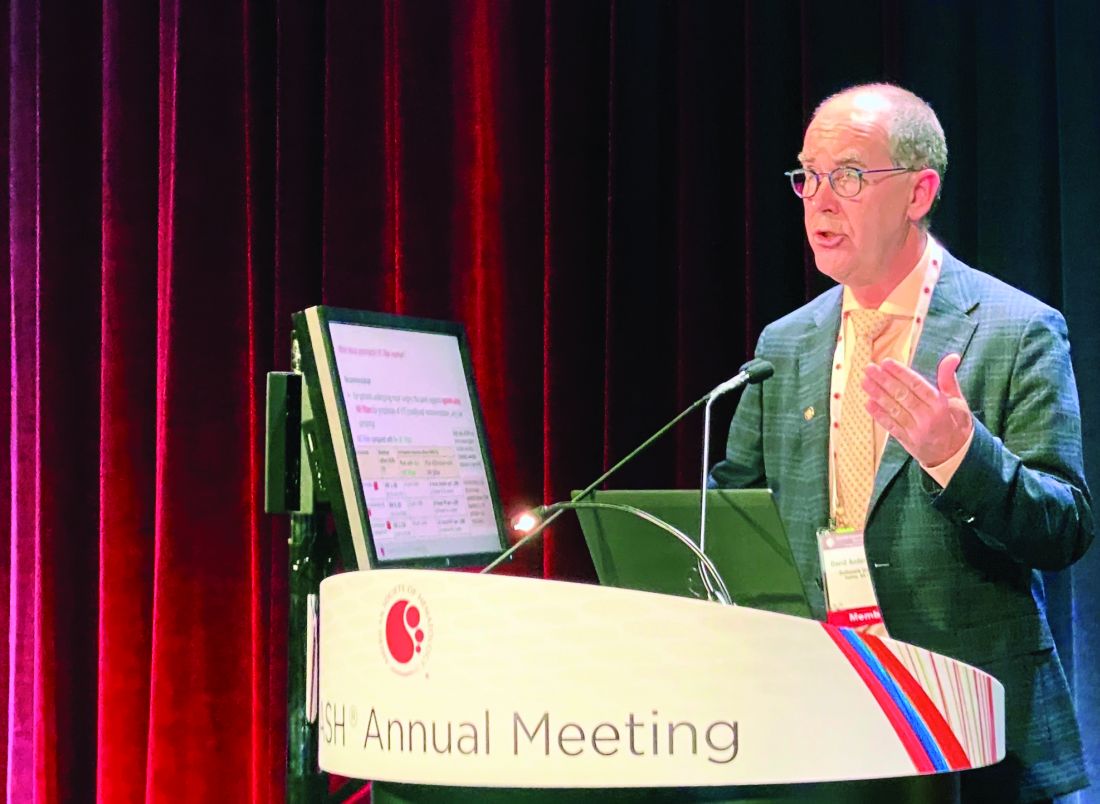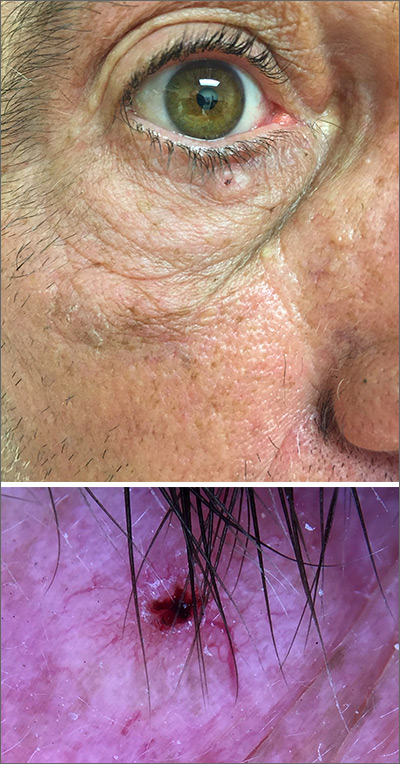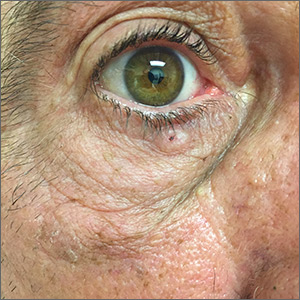User login
Orelabrutinib could be ‘preferred’ BTK inhibitor for MCL
ORLANDO – A novel Bruton tyrosine kinase inhibitor has produced favorable results in patients with relapsed or refractory mantle cell lymphoma, according to findings presented at the annual meeting of the American Society of Hematology.
In a phase 2 trial, orelabrutinib produced an overall response rate of 86% and a 12-month progression-free survival rate of 64%. Safety results with orelabrutinib were superior to historical results with ibrutinib.
The efficacy and safety profile of orelabrutinib, as well as its “convenient” dosing, may make it the “preferred therapeutic choice for B-cell malignancy,” said Lijuan Deng, MD, PhD, of Peking University Cancer Hospital & Institute, Beijing, who presented the phase 2 trial of orelabrutinib at ASH 2019.
The trial enrolled 106 patients with relapsed/refractory mantle cell lymphoma who were treated at 22 centers in China. At baseline, the patients had a median age of 62 years (range, 37-73 years), and 79.2% were men. Most patients (94.4%) had stage III-IV disease.
Prior therapies included CHOP (cyclophosphamide, doxorubicin, vincristine, and prednisolone)-based (69.8%), EPOCH (etoposide, prednisone, vincristine, cyclophosphamide, and doxorubicin)-based (22.6%), DHAP (dexamethasone, cytarabine, and cisplatin)-based (22.6%), CVAD (cyclophosphamide, vincristine, doxorubicin, dexamethasone)-based (12.3%), and ESHAP (etoposide, methylprednisolone, cytarabine, and cisplatin)-based (4.7%) regimens, and 88.7% of patients had received prior anti-CD20 therapy.
Patients received orelabrutinib at 100 mg twice daily (n = 20) or 150 mg once a day (n = 86). All 106 patients were evaluable for safety, and 99 were evaluable for efficacy.
Efficacy
“Orelabrutinib achieved high response and durable remissions,” Dr. Deng said.
The overall response rate was 85.9% in the evaluable efficacy population and 83.5% in the 150-mg dosing arm. The complete response rates were 27.3% and 29.1%, respectively. The median time to response, overall, was 1.9 months.
The median duration of response and median progression-free survival were not reached at a median follow-up of 10.5 months. At 12 months, 74.3% of patients were still in response, and the progression-free survival rate was 64%.
Safety
Most adverse events were grade 1-2 in nature. The most common grade 3 or higher events were platelet count decrease (11.3%), neutrophil count decrease (8.5%), anemia (7.5%), hypertension (3.8%), pneumonia (2.8%), white blood count decrease (1.9%), and hypokalemia (1.9%).
Adverse events of interest included grade 3 or higher hypertension (3.8%), diarrhea (6.6%), and infection (10.4%), as well as secondary malignancy (0.9%, n = 1). There were no cases of grade 3 or higher hemorrhage, grade 3 or higher atrial fibrillation/flutter, or grade 5 treatment-related adverse events.
Dr. Deng noted that rates of grade 3 or higher hemorrhage, atrial fibrillation, diarrhea, and infection, as well as rates of secondary malignancies, have historically been higher with ibrutinib (Blood. 2015 Aug 6;126[6]:739-45; Lancet. 2016 Feb 20;387[10020]:770-8).
“Orelabrutinib has an improved safety profile in patients with relapsed or refractory mantle cell lymphoma,” Dr. Deng said. “The most common adverse events were cytopenia and infections, which are considered mechanism based.”
The study was sponsored by InnoCare Pharma. Dr. Deng reported having no conflicts of interest.
SOURCE: Deng L et al. ASH 2019, Abstract 755.
ORLANDO – A novel Bruton tyrosine kinase inhibitor has produced favorable results in patients with relapsed or refractory mantle cell lymphoma, according to findings presented at the annual meeting of the American Society of Hematology.
In a phase 2 trial, orelabrutinib produced an overall response rate of 86% and a 12-month progression-free survival rate of 64%. Safety results with orelabrutinib were superior to historical results with ibrutinib.
The efficacy and safety profile of orelabrutinib, as well as its “convenient” dosing, may make it the “preferred therapeutic choice for B-cell malignancy,” said Lijuan Deng, MD, PhD, of Peking University Cancer Hospital & Institute, Beijing, who presented the phase 2 trial of orelabrutinib at ASH 2019.
The trial enrolled 106 patients with relapsed/refractory mantle cell lymphoma who were treated at 22 centers in China. At baseline, the patients had a median age of 62 years (range, 37-73 years), and 79.2% were men. Most patients (94.4%) had stage III-IV disease.
Prior therapies included CHOP (cyclophosphamide, doxorubicin, vincristine, and prednisolone)-based (69.8%), EPOCH (etoposide, prednisone, vincristine, cyclophosphamide, and doxorubicin)-based (22.6%), DHAP (dexamethasone, cytarabine, and cisplatin)-based (22.6%), CVAD (cyclophosphamide, vincristine, doxorubicin, dexamethasone)-based (12.3%), and ESHAP (etoposide, methylprednisolone, cytarabine, and cisplatin)-based (4.7%) regimens, and 88.7% of patients had received prior anti-CD20 therapy.
Patients received orelabrutinib at 100 mg twice daily (n = 20) or 150 mg once a day (n = 86). All 106 patients were evaluable for safety, and 99 were evaluable for efficacy.
Efficacy
“Orelabrutinib achieved high response and durable remissions,” Dr. Deng said.
The overall response rate was 85.9% in the evaluable efficacy population and 83.5% in the 150-mg dosing arm. The complete response rates were 27.3% and 29.1%, respectively. The median time to response, overall, was 1.9 months.
The median duration of response and median progression-free survival were not reached at a median follow-up of 10.5 months. At 12 months, 74.3% of patients were still in response, and the progression-free survival rate was 64%.
Safety
Most adverse events were grade 1-2 in nature. The most common grade 3 or higher events were platelet count decrease (11.3%), neutrophil count decrease (8.5%), anemia (7.5%), hypertension (3.8%), pneumonia (2.8%), white blood count decrease (1.9%), and hypokalemia (1.9%).
Adverse events of interest included grade 3 or higher hypertension (3.8%), diarrhea (6.6%), and infection (10.4%), as well as secondary malignancy (0.9%, n = 1). There were no cases of grade 3 or higher hemorrhage, grade 3 or higher atrial fibrillation/flutter, or grade 5 treatment-related adverse events.
Dr. Deng noted that rates of grade 3 or higher hemorrhage, atrial fibrillation, diarrhea, and infection, as well as rates of secondary malignancies, have historically been higher with ibrutinib (Blood. 2015 Aug 6;126[6]:739-45; Lancet. 2016 Feb 20;387[10020]:770-8).
“Orelabrutinib has an improved safety profile in patients with relapsed or refractory mantle cell lymphoma,” Dr. Deng said. “The most common adverse events were cytopenia and infections, which are considered mechanism based.”
The study was sponsored by InnoCare Pharma. Dr. Deng reported having no conflicts of interest.
SOURCE: Deng L et al. ASH 2019, Abstract 755.
ORLANDO – A novel Bruton tyrosine kinase inhibitor has produced favorable results in patients with relapsed or refractory mantle cell lymphoma, according to findings presented at the annual meeting of the American Society of Hematology.
In a phase 2 trial, orelabrutinib produced an overall response rate of 86% and a 12-month progression-free survival rate of 64%. Safety results with orelabrutinib were superior to historical results with ibrutinib.
The efficacy and safety profile of orelabrutinib, as well as its “convenient” dosing, may make it the “preferred therapeutic choice for B-cell malignancy,” said Lijuan Deng, MD, PhD, of Peking University Cancer Hospital & Institute, Beijing, who presented the phase 2 trial of orelabrutinib at ASH 2019.
The trial enrolled 106 patients with relapsed/refractory mantle cell lymphoma who were treated at 22 centers in China. At baseline, the patients had a median age of 62 years (range, 37-73 years), and 79.2% were men. Most patients (94.4%) had stage III-IV disease.
Prior therapies included CHOP (cyclophosphamide, doxorubicin, vincristine, and prednisolone)-based (69.8%), EPOCH (etoposide, prednisone, vincristine, cyclophosphamide, and doxorubicin)-based (22.6%), DHAP (dexamethasone, cytarabine, and cisplatin)-based (22.6%), CVAD (cyclophosphamide, vincristine, doxorubicin, dexamethasone)-based (12.3%), and ESHAP (etoposide, methylprednisolone, cytarabine, and cisplatin)-based (4.7%) regimens, and 88.7% of patients had received prior anti-CD20 therapy.
Patients received orelabrutinib at 100 mg twice daily (n = 20) or 150 mg once a day (n = 86). All 106 patients were evaluable for safety, and 99 were evaluable for efficacy.
Efficacy
“Orelabrutinib achieved high response and durable remissions,” Dr. Deng said.
The overall response rate was 85.9% in the evaluable efficacy population and 83.5% in the 150-mg dosing arm. The complete response rates were 27.3% and 29.1%, respectively. The median time to response, overall, was 1.9 months.
The median duration of response and median progression-free survival were not reached at a median follow-up of 10.5 months. At 12 months, 74.3% of patients were still in response, and the progression-free survival rate was 64%.
Safety
Most adverse events were grade 1-2 in nature. The most common grade 3 or higher events were platelet count decrease (11.3%), neutrophil count decrease (8.5%), anemia (7.5%), hypertension (3.8%), pneumonia (2.8%), white blood count decrease (1.9%), and hypokalemia (1.9%).
Adverse events of interest included grade 3 or higher hypertension (3.8%), diarrhea (6.6%), and infection (10.4%), as well as secondary malignancy (0.9%, n = 1). There were no cases of grade 3 or higher hemorrhage, grade 3 or higher atrial fibrillation/flutter, or grade 5 treatment-related adverse events.
Dr. Deng noted that rates of grade 3 or higher hemorrhage, atrial fibrillation, diarrhea, and infection, as well as rates of secondary malignancies, have historically been higher with ibrutinib (Blood. 2015 Aug 6;126[6]:739-45; Lancet. 2016 Feb 20;387[10020]:770-8).
“Orelabrutinib has an improved safety profile in patients with relapsed or refractory mantle cell lymphoma,” Dr. Deng said. “The most common adverse events were cytopenia and infections, which are considered mechanism based.”
The study was sponsored by InnoCare Pharma. Dr. Deng reported having no conflicts of interest.
SOURCE: Deng L et al. ASH 2019, Abstract 755.
REPORTING FROM ASH 2019
Tucatinib called game-changer in HER2-positive metastatic breast cancer
SAN ANTONIO – Tucatinib, an investigational oral inhibitor of human epidermal growth factor receptor 2 (HER2) tyrosine kinase, constitutes a major advance in the treatment of heavily pretreated HER2-positive metastatic breast cancer – including patients with brain metastases, Rashmi K. Murthy, MD, declared at the San Antonio Breast Cancer Symposium.
She presented the results of the pivotal HER2CLIMB trial, in which 612 women with heavily pretreated HER2-positive metastatic breast cancer were randomized two-to-one to oral tucatinib at 300 mg twice daily or placebo in combination with standard guideline-recommended treatment with trastuzumab and capecitabine. This landmark double-blind study, conducted at 155 sites in 15 countries, was the first-ever randomized trial to include HER2-positive metastatic breast cancer patients with baseline untreated or previously treated but progressing brain metastases; indeed, nearly half of participants had baseline brain metastases, 40% of which were untreated or treated and progressing.
Not only did tucatinib on top of background trastuzumab and capecitabine reduce the risk of death by 34% compared with placebo, it also more than doubled progression-free survival. And most encouragingly, it did so in patients with or without baseline brain metastases.
“I would like to take a minute here to highlight that this overall survival benefit was seen in patients who had already received trastuzumab, pertuzumab, and T-DM1 [trastuzumab emtansine] and included patients who had brain metastases. Tucatinib in combination with trastuzumab and capecitabine has the potential to become a new standard of care in this population with and without brain metastases,” said Dr. Murthy, a medical oncologist at the University of Texas MD Anderson Cancer Center, Houston.
Tucatinib, which crosses the blood-brain barrier, is highly selective for the kinase domain of HER2, with only miniscule inhibition of epidermal growth factor receptor. Its high selectivity is reflected in a favorable tolerability profile: Only 6% of patients discontinued tucatinib because of adverse events. This low discontinuation rate permitted longer treatment, even in this heavily pretreated population.
The most common adverse events in the tucatinib study arm were diarrhea, hand-foot syndrome, nausea, fatigue, and vomiting, with most cases being low grade. Diarrhea, the most common adverse event, occurred in 81% of tucatinib-treated patients and 53% of controls. However, only 13% of the tucatinib group experienced grade 3 or worse diarrhea. Notably, antidiarrheal prophylaxis wasn’t mandated in HER2CLIMB. Antidiarrheal medications were utilized in less than half of the treatment cycles where diarrhea was reported, and even then, for a median of only 3 days per cycle.
Median study follow-up was 14 months. The primary study endpoint – 1-year progression-free survival assessed by blinded independent central review – was 33% in the tucatinib group and 12% in controls. Thus, the risk of disease progression or death was reduced by 46% in the tucatinib group. The median duration of progression-free survival was 7.8 months in tucatinib-treated patients, compared with 5.6 months in controls.
Two-year estimated overall survival was 45% with tucatinib and 27% with placebo. The tucatinib group’s 21.9-month median overall survival was 4.5 months greater than in controls.
One-year estimated progression-free survival in patients with baseline brain metastases was 25% in the tucatinib group and zero in controls.
The confirmed objective response rate was 41% in the tucatinib group, nearly double the 23% figure in controls.
The overall and progression-free survival results were consistent across all prespecified subgroups based upon age, race, hormone receptor status, geographic location, and other factors.
The study met with an extremely favorable reception peppered with comments such as “tremendous results.”
“I think that the HER2CLIMB study is practice-changing,” Hope S. Rugo, MD, said in an interview.
“The overall survival benefit in all patients and in those who have brain metastases is clinically relevant for our patients who have HER2-positive metastatic breast cancer treated with trastuzumab, pertuzumab, and T-DMI. In addition, the toxicity profile is superior to prior oral TKIs, which is a huge issue for our patients with metastatic disease,” observed Dr. Rugo, professor of medicine and director of breast oncology and clinical trials education at the University of California, San Francisco.
The HER2CLIMB results raise an important question for future research: Namely, could tucatinib have a role in preventing brain metastases by giving the drug earlier in the course of treatment of patients who are at high risk for developing brain metastases, she added.
Simultaneously with Dr. Murthy’s presentation in San Antonio, the HER2CLIMB results were published online in the New England Journal of Medicine.
Dr. Murthy reported receiving institutional research support from and serving as a consultant to Seattle Genetics, sponsor of the HER2CLIMB trial, as well as from several other pharmaceutical companies.
SOURCE: Murthy RK. SABCS 2019 Abstract GS1-01.
SAN ANTONIO – Tucatinib, an investigational oral inhibitor of human epidermal growth factor receptor 2 (HER2) tyrosine kinase, constitutes a major advance in the treatment of heavily pretreated HER2-positive metastatic breast cancer – including patients with brain metastases, Rashmi K. Murthy, MD, declared at the San Antonio Breast Cancer Symposium.
She presented the results of the pivotal HER2CLIMB trial, in which 612 women with heavily pretreated HER2-positive metastatic breast cancer were randomized two-to-one to oral tucatinib at 300 mg twice daily or placebo in combination with standard guideline-recommended treatment with trastuzumab and capecitabine. This landmark double-blind study, conducted at 155 sites in 15 countries, was the first-ever randomized trial to include HER2-positive metastatic breast cancer patients with baseline untreated or previously treated but progressing brain metastases; indeed, nearly half of participants had baseline brain metastases, 40% of which were untreated or treated and progressing.
Not only did tucatinib on top of background trastuzumab and capecitabine reduce the risk of death by 34% compared with placebo, it also more than doubled progression-free survival. And most encouragingly, it did so in patients with or without baseline brain metastases.
“I would like to take a minute here to highlight that this overall survival benefit was seen in patients who had already received trastuzumab, pertuzumab, and T-DM1 [trastuzumab emtansine] and included patients who had brain metastases. Tucatinib in combination with trastuzumab and capecitabine has the potential to become a new standard of care in this population with and without brain metastases,” said Dr. Murthy, a medical oncologist at the University of Texas MD Anderson Cancer Center, Houston.
Tucatinib, which crosses the blood-brain barrier, is highly selective for the kinase domain of HER2, with only miniscule inhibition of epidermal growth factor receptor. Its high selectivity is reflected in a favorable tolerability profile: Only 6% of patients discontinued tucatinib because of adverse events. This low discontinuation rate permitted longer treatment, even in this heavily pretreated population.
The most common adverse events in the tucatinib study arm were diarrhea, hand-foot syndrome, nausea, fatigue, and vomiting, with most cases being low grade. Diarrhea, the most common adverse event, occurred in 81% of tucatinib-treated patients and 53% of controls. However, only 13% of the tucatinib group experienced grade 3 or worse diarrhea. Notably, antidiarrheal prophylaxis wasn’t mandated in HER2CLIMB. Antidiarrheal medications were utilized in less than half of the treatment cycles where diarrhea was reported, and even then, for a median of only 3 days per cycle.
Median study follow-up was 14 months. The primary study endpoint – 1-year progression-free survival assessed by blinded independent central review – was 33% in the tucatinib group and 12% in controls. Thus, the risk of disease progression or death was reduced by 46% in the tucatinib group. The median duration of progression-free survival was 7.8 months in tucatinib-treated patients, compared with 5.6 months in controls.
Two-year estimated overall survival was 45% with tucatinib and 27% with placebo. The tucatinib group’s 21.9-month median overall survival was 4.5 months greater than in controls.
One-year estimated progression-free survival in patients with baseline brain metastases was 25% in the tucatinib group and zero in controls.
The confirmed objective response rate was 41% in the tucatinib group, nearly double the 23% figure in controls.
The overall and progression-free survival results were consistent across all prespecified subgroups based upon age, race, hormone receptor status, geographic location, and other factors.
The study met with an extremely favorable reception peppered with comments such as “tremendous results.”
“I think that the HER2CLIMB study is practice-changing,” Hope S. Rugo, MD, said in an interview.
“The overall survival benefit in all patients and in those who have brain metastases is clinically relevant for our patients who have HER2-positive metastatic breast cancer treated with trastuzumab, pertuzumab, and T-DMI. In addition, the toxicity profile is superior to prior oral TKIs, which is a huge issue for our patients with metastatic disease,” observed Dr. Rugo, professor of medicine and director of breast oncology and clinical trials education at the University of California, San Francisco.
The HER2CLIMB results raise an important question for future research: Namely, could tucatinib have a role in preventing brain metastases by giving the drug earlier in the course of treatment of patients who are at high risk for developing brain metastases, she added.
Simultaneously with Dr. Murthy’s presentation in San Antonio, the HER2CLIMB results were published online in the New England Journal of Medicine.
Dr. Murthy reported receiving institutional research support from and serving as a consultant to Seattle Genetics, sponsor of the HER2CLIMB trial, as well as from several other pharmaceutical companies.
SOURCE: Murthy RK. SABCS 2019 Abstract GS1-01.
SAN ANTONIO – Tucatinib, an investigational oral inhibitor of human epidermal growth factor receptor 2 (HER2) tyrosine kinase, constitutes a major advance in the treatment of heavily pretreated HER2-positive metastatic breast cancer – including patients with brain metastases, Rashmi K. Murthy, MD, declared at the San Antonio Breast Cancer Symposium.
She presented the results of the pivotal HER2CLIMB trial, in which 612 women with heavily pretreated HER2-positive metastatic breast cancer were randomized two-to-one to oral tucatinib at 300 mg twice daily or placebo in combination with standard guideline-recommended treatment with trastuzumab and capecitabine. This landmark double-blind study, conducted at 155 sites in 15 countries, was the first-ever randomized trial to include HER2-positive metastatic breast cancer patients with baseline untreated or previously treated but progressing brain metastases; indeed, nearly half of participants had baseline brain metastases, 40% of which were untreated or treated and progressing.
Not only did tucatinib on top of background trastuzumab and capecitabine reduce the risk of death by 34% compared with placebo, it also more than doubled progression-free survival. And most encouragingly, it did so in patients with or without baseline brain metastases.
“I would like to take a minute here to highlight that this overall survival benefit was seen in patients who had already received trastuzumab, pertuzumab, and T-DM1 [trastuzumab emtansine] and included patients who had brain metastases. Tucatinib in combination with trastuzumab and capecitabine has the potential to become a new standard of care in this population with and without brain metastases,” said Dr. Murthy, a medical oncologist at the University of Texas MD Anderson Cancer Center, Houston.
Tucatinib, which crosses the blood-brain barrier, is highly selective for the kinase domain of HER2, with only miniscule inhibition of epidermal growth factor receptor. Its high selectivity is reflected in a favorable tolerability profile: Only 6% of patients discontinued tucatinib because of adverse events. This low discontinuation rate permitted longer treatment, even in this heavily pretreated population.
The most common adverse events in the tucatinib study arm were diarrhea, hand-foot syndrome, nausea, fatigue, and vomiting, with most cases being low grade. Diarrhea, the most common adverse event, occurred in 81% of tucatinib-treated patients and 53% of controls. However, only 13% of the tucatinib group experienced grade 3 or worse diarrhea. Notably, antidiarrheal prophylaxis wasn’t mandated in HER2CLIMB. Antidiarrheal medications were utilized in less than half of the treatment cycles where diarrhea was reported, and even then, for a median of only 3 days per cycle.
Median study follow-up was 14 months. The primary study endpoint – 1-year progression-free survival assessed by blinded independent central review – was 33% in the tucatinib group and 12% in controls. Thus, the risk of disease progression or death was reduced by 46% in the tucatinib group. The median duration of progression-free survival was 7.8 months in tucatinib-treated patients, compared with 5.6 months in controls.
Two-year estimated overall survival was 45% with tucatinib and 27% with placebo. The tucatinib group’s 21.9-month median overall survival was 4.5 months greater than in controls.
One-year estimated progression-free survival in patients with baseline brain metastases was 25% in the tucatinib group and zero in controls.
The confirmed objective response rate was 41% in the tucatinib group, nearly double the 23% figure in controls.
The overall and progression-free survival results were consistent across all prespecified subgroups based upon age, race, hormone receptor status, geographic location, and other factors.
The study met with an extremely favorable reception peppered with comments such as “tremendous results.”
“I think that the HER2CLIMB study is practice-changing,” Hope S. Rugo, MD, said in an interview.
“The overall survival benefit in all patients and in those who have brain metastases is clinically relevant for our patients who have HER2-positive metastatic breast cancer treated with trastuzumab, pertuzumab, and T-DMI. In addition, the toxicity profile is superior to prior oral TKIs, which is a huge issue for our patients with metastatic disease,” observed Dr. Rugo, professor of medicine and director of breast oncology and clinical trials education at the University of California, San Francisco.
The HER2CLIMB results raise an important question for future research: Namely, could tucatinib have a role in preventing brain metastases by giving the drug earlier in the course of treatment of patients who are at high risk for developing brain metastases, she added.
Simultaneously with Dr. Murthy’s presentation in San Antonio, the HER2CLIMB results were published online in the New England Journal of Medicine.
Dr. Murthy reported receiving institutional research support from and serving as a consultant to Seattle Genetics, sponsor of the HER2CLIMB trial, as well as from several other pharmaceutical companies.
SOURCE: Murthy RK. SABCS 2019 Abstract GS1-01.
REPORTING FROM SABCS 2019
Trastuzumab deruxtecan has good activity in advanced HER2-positive breast cancer
SAN ANTONIO –A novel antibody-drug conjugate pairing trastuzumab (Herceptin) with a topoisomerase I inhibitor as the toxic payload was associated with a good overall response rate in patients with heavily pretreated HER2-positive metastatic breast cancer.
The confirmed overall response rate among 184 patients treated with trastuzumab deruxtecan and followed for a median of 11.1 months was 60.9%, consisting of 6% complete responses and 54.9% partial responses, reported Ian Krop, MD, PhD, from the Dana-Farber Cancer Institute in Boston.
“These data demonstrate the potential of trastuzumab deruxtecan to establish a new standard of care for patients with advanced HER2-positive breast cancer,” he said at a briefing prior to presentation of the data at the San Antonio Breast Cancer Symposium.
Results of the open-label phase 2 DESTINY-BREAST01 study were also published online in the New England Journal of Medicine.
Although the antibody-drug conjugate was associated with a good response rate among heavily pretreated patients (median of six prior lines of therapy), it was also associated with interstitial lung disease (ILD), including 4 fatalities among 184 patients who received the drug at the recommended study dose of 5.4 mg/kg.
“ILD is confirmed as an important risk of trastuzumab deruxtecan, it can be severe, and requires careful monitoring and prompt intervention,” Dr. Krop said.
Trastuzumab deruxtecan is composed of a humanized anti-HER2 IgG1 monoclonal antibody with the same amino acid sequence as trastuzumab, and exatecan derivative as the topoisomerase I inhibitor payload conjugated by a tetrapeptide-based cleavable linker.
Although topoisomerase I inhibitors are not commonly used in breast cancer because of limited activity in clinical trials and toxicities when used systemically, the rationale for using a topoisomerase I inhibitor in this setting is that the toxic effects can be largely confined to the local tumor environment.
In addition, “this is an agent that the cancers generally haven’t been exposed to, so there is the hope this will be non–cross-resistant,” Dr. Krop said at the briefing.
The product has a high drug molecule-to-antibody ratio or approximately 8:1, which is higher than that seen with other antibody-drug conjugates, and the topoisomerase inhibitor payload is membrane permeable, giving it extra potency.
Study details
DESTINY-BREAST01 is an open-label, multicenter, phase 2 study consisting of a dose-finding phase and a continuous phase. Dr. Krop reported on all 184 patients who have been treated at the recommend 5.4-mg/kg dose.
As noted, the patients had received a median of 6 prior lines of therapy, with at least one patient receiving a staggering 27 prior lines. All had previously received trastuzumab and a different antibody-drug conjugate, ado-trastuzumab emtansine (T-DMI; Kadcyla). Two-thirds of patients (65.8%) had received pertuzumab (Perjeta), 54.3% received other anti-HER2 therapies. 48.9% had received hormone therapy, and 99.5% had received other systemic therapies.
ORR by independent review, the primary endpoint, was as noted before. In addition to the 60.9% ORR, 36.4% of patients had stable disease, for a disease control rate of 97.3%.
The median time to response was 1.6 month, and the median duration of response was 14.8 months.
The median progression-free survival at follow-up was 16.4 months. The median overall survival had not been reached at the time of data cutoff in August 2019.
Interstitial lung disease
After a median treatment duration of 10 months, all but one patient had at least one drug-related adverse event. Grade 3 or greater drug-related adverse events occurred in 48.4% of patients, and serious drug-related events occurred in 12.5%.
A total of 25 patients had ILD of any grade, including 5 with grade 1, 15 with grade 2, 1 with grade 4, and the aforementioned 4 patients who died from the disease.
In the four patients with fatal ILD, onset ranged from 63-146, with the deaths occurring 9-60 days after ILD diagnosis. Three of the patients had received steroids as part of their ILD treatment.
The investigators recommend close monitoring of patients for signs and symptoms of lung disease, including fever, cough, or dyspnea. They also recommend that patients with suspected ILD be evaluated with high-resolution CT and testing for pulmonary function and oxygen saturation, ideally under consultation with a pulmonologist.
However, despite the known cardiotoxic effects of trastuzumab, there were no reported cases of heart failure with decline in left ventricular ejection fraction, and only three patients had a decrease in left ventricular ejection fraction, none of which grade 4.
“The response rate and overall efficacy observed with trastuzumab deruxtecan in this study appear to substantially exceed those of currently available HER2-directed regimens and new agents in development, although cross-trial comparisons must be interpreted with caution,” the investigators wrote in the New England Journal of Medicine.
The study was funded by Daiichi Sankyo and AstraZeneca. Dr. Krop disclosed consulting fees, honoraria from each company, and research support from Genentech/Roche and Pfizer.
SOURCE: Krop I et al. SABCS 2019, Abstract GS1-03.
SAN ANTONIO –A novel antibody-drug conjugate pairing trastuzumab (Herceptin) with a topoisomerase I inhibitor as the toxic payload was associated with a good overall response rate in patients with heavily pretreated HER2-positive metastatic breast cancer.
The confirmed overall response rate among 184 patients treated with trastuzumab deruxtecan and followed for a median of 11.1 months was 60.9%, consisting of 6% complete responses and 54.9% partial responses, reported Ian Krop, MD, PhD, from the Dana-Farber Cancer Institute in Boston.
“These data demonstrate the potential of trastuzumab deruxtecan to establish a new standard of care for patients with advanced HER2-positive breast cancer,” he said at a briefing prior to presentation of the data at the San Antonio Breast Cancer Symposium.
Results of the open-label phase 2 DESTINY-BREAST01 study were also published online in the New England Journal of Medicine.
Although the antibody-drug conjugate was associated with a good response rate among heavily pretreated patients (median of six prior lines of therapy), it was also associated with interstitial lung disease (ILD), including 4 fatalities among 184 patients who received the drug at the recommended study dose of 5.4 mg/kg.
“ILD is confirmed as an important risk of trastuzumab deruxtecan, it can be severe, and requires careful monitoring and prompt intervention,” Dr. Krop said.
Trastuzumab deruxtecan is composed of a humanized anti-HER2 IgG1 monoclonal antibody with the same amino acid sequence as trastuzumab, and exatecan derivative as the topoisomerase I inhibitor payload conjugated by a tetrapeptide-based cleavable linker.
Although topoisomerase I inhibitors are not commonly used in breast cancer because of limited activity in clinical trials and toxicities when used systemically, the rationale for using a topoisomerase I inhibitor in this setting is that the toxic effects can be largely confined to the local tumor environment.
In addition, “this is an agent that the cancers generally haven’t been exposed to, so there is the hope this will be non–cross-resistant,” Dr. Krop said at the briefing.
The product has a high drug molecule-to-antibody ratio or approximately 8:1, which is higher than that seen with other antibody-drug conjugates, and the topoisomerase inhibitor payload is membrane permeable, giving it extra potency.
Study details
DESTINY-BREAST01 is an open-label, multicenter, phase 2 study consisting of a dose-finding phase and a continuous phase. Dr. Krop reported on all 184 patients who have been treated at the recommend 5.4-mg/kg dose.
As noted, the patients had received a median of 6 prior lines of therapy, with at least one patient receiving a staggering 27 prior lines. All had previously received trastuzumab and a different antibody-drug conjugate, ado-trastuzumab emtansine (T-DMI; Kadcyla). Two-thirds of patients (65.8%) had received pertuzumab (Perjeta), 54.3% received other anti-HER2 therapies. 48.9% had received hormone therapy, and 99.5% had received other systemic therapies.
ORR by independent review, the primary endpoint, was as noted before. In addition to the 60.9% ORR, 36.4% of patients had stable disease, for a disease control rate of 97.3%.
The median time to response was 1.6 month, and the median duration of response was 14.8 months.
The median progression-free survival at follow-up was 16.4 months. The median overall survival had not been reached at the time of data cutoff in August 2019.
Interstitial lung disease
After a median treatment duration of 10 months, all but one patient had at least one drug-related adverse event. Grade 3 or greater drug-related adverse events occurred in 48.4% of patients, and serious drug-related events occurred in 12.5%.
A total of 25 patients had ILD of any grade, including 5 with grade 1, 15 with grade 2, 1 with grade 4, and the aforementioned 4 patients who died from the disease.
In the four patients with fatal ILD, onset ranged from 63-146, with the deaths occurring 9-60 days after ILD diagnosis. Three of the patients had received steroids as part of their ILD treatment.
The investigators recommend close monitoring of patients for signs and symptoms of lung disease, including fever, cough, or dyspnea. They also recommend that patients with suspected ILD be evaluated with high-resolution CT and testing for pulmonary function and oxygen saturation, ideally under consultation with a pulmonologist.
However, despite the known cardiotoxic effects of trastuzumab, there were no reported cases of heart failure with decline in left ventricular ejection fraction, and only three patients had a decrease in left ventricular ejection fraction, none of which grade 4.
“The response rate and overall efficacy observed with trastuzumab deruxtecan in this study appear to substantially exceed those of currently available HER2-directed regimens and new agents in development, although cross-trial comparisons must be interpreted with caution,” the investigators wrote in the New England Journal of Medicine.
The study was funded by Daiichi Sankyo and AstraZeneca. Dr. Krop disclosed consulting fees, honoraria from each company, and research support from Genentech/Roche and Pfizer.
SOURCE: Krop I et al. SABCS 2019, Abstract GS1-03.
SAN ANTONIO –A novel antibody-drug conjugate pairing trastuzumab (Herceptin) with a topoisomerase I inhibitor as the toxic payload was associated with a good overall response rate in patients with heavily pretreated HER2-positive metastatic breast cancer.
The confirmed overall response rate among 184 patients treated with trastuzumab deruxtecan and followed for a median of 11.1 months was 60.9%, consisting of 6% complete responses and 54.9% partial responses, reported Ian Krop, MD, PhD, from the Dana-Farber Cancer Institute in Boston.
“These data demonstrate the potential of trastuzumab deruxtecan to establish a new standard of care for patients with advanced HER2-positive breast cancer,” he said at a briefing prior to presentation of the data at the San Antonio Breast Cancer Symposium.
Results of the open-label phase 2 DESTINY-BREAST01 study were also published online in the New England Journal of Medicine.
Although the antibody-drug conjugate was associated with a good response rate among heavily pretreated patients (median of six prior lines of therapy), it was also associated with interstitial lung disease (ILD), including 4 fatalities among 184 patients who received the drug at the recommended study dose of 5.4 mg/kg.
“ILD is confirmed as an important risk of trastuzumab deruxtecan, it can be severe, and requires careful monitoring and prompt intervention,” Dr. Krop said.
Trastuzumab deruxtecan is composed of a humanized anti-HER2 IgG1 monoclonal antibody with the same amino acid sequence as trastuzumab, and exatecan derivative as the topoisomerase I inhibitor payload conjugated by a tetrapeptide-based cleavable linker.
Although topoisomerase I inhibitors are not commonly used in breast cancer because of limited activity in clinical trials and toxicities when used systemically, the rationale for using a topoisomerase I inhibitor in this setting is that the toxic effects can be largely confined to the local tumor environment.
In addition, “this is an agent that the cancers generally haven’t been exposed to, so there is the hope this will be non–cross-resistant,” Dr. Krop said at the briefing.
The product has a high drug molecule-to-antibody ratio or approximately 8:1, which is higher than that seen with other antibody-drug conjugates, and the topoisomerase inhibitor payload is membrane permeable, giving it extra potency.
Study details
DESTINY-BREAST01 is an open-label, multicenter, phase 2 study consisting of a dose-finding phase and a continuous phase. Dr. Krop reported on all 184 patients who have been treated at the recommend 5.4-mg/kg dose.
As noted, the patients had received a median of 6 prior lines of therapy, with at least one patient receiving a staggering 27 prior lines. All had previously received trastuzumab and a different antibody-drug conjugate, ado-trastuzumab emtansine (T-DMI; Kadcyla). Two-thirds of patients (65.8%) had received pertuzumab (Perjeta), 54.3% received other anti-HER2 therapies. 48.9% had received hormone therapy, and 99.5% had received other systemic therapies.
ORR by independent review, the primary endpoint, was as noted before. In addition to the 60.9% ORR, 36.4% of patients had stable disease, for a disease control rate of 97.3%.
The median time to response was 1.6 month, and the median duration of response was 14.8 months.
The median progression-free survival at follow-up was 16.4 months. The median overall survival had not been reached at the time of data cutoff in August 2019.
Interstitial lung disease
After a median treatment duration of 10 months, all but one patient had at least one drug-related adverse event. Grade 3 or greater drug-related adverse events occurred in 48.4% of patients, and serious drug-related events occurred in 12.5%.
A total of 25 patients had ILD of any grade, including 5 with grade 1, 15 with grade 2, 1 with grade 4, and the aforementioned 4 patients who died from the disease.
In the four patients with fatal ILD, onset ranged from 63-146, with the deaths occurring 9-60 days after ILD diagnosis. Three of the patients had received steroids as part of their ILD treatment.
The investigators recommend close monitoring of patients for signs and symptoms of lung disease, including fever, cough, or dyspnea. They also recommend that patients with suspected ILD be evaluated with high-resolution CT and testing for pulmonary function and oxygen saturation, ideally under consultation with a pulmonologist.
However, despite the known cardiotoxic effects of trastuzumab, there were no reported cases of heart failure with decline in left ventricular ejection fraction, and only three patients had a decrease in left ventricular ejection fraction, none of which grade 4.
“The response rate and overall efficacy observed with trastuzumab deruxtecan in this study appear to substantially exceed those of currently available HER2-directed regimens and new agents in development, although cross-trial comparisons must be interpreted with caution,” the investigators wrote in the New England Journal of Medicine.
The study was funded by Daiichi Sankyo and AstraZeneca. Dr. Krop disclosed consulting fees, honoraria from each company, and research support from Genentech/Roche and Pfizer.
SOURCE: Krop I et al. SABCS 2019, Abstract GS1-03.
REPORTING FROM SABCS 2019
Tales of nasal terror, and dental hoverboarding
A cure for nosiness
Christmas may be just around the corner, but is there ever really a wrong time to huddle around a campfire and swap scary stories? So bundle up, get the fire going, and prepare yourselves for a pair of nasal-based horror stories that will frighten your Jingle Bells off!
Our first tale of nostril terror comes all the way from southern India, where a 13-year-old boy jumped into a water well to cool off. Hey, southern India gets hot, even in November. But like something out of a bad sci-fi movie, his peaceful swim was interrupted when something swam up his nose, causing him extreme pain. After a 30-minute procedure, the doctor pulled out the culprit: A horrific alien parasite! Okay, we’re lying; it was a fish. But we had you going, didn’t we?
Well, maybe that didn’t get you frightened. But we have more rhinal dread to share! A young girl in Las Vegas stuck a pair of plastic doll shoes up her nose, one in each nostril. Her mother removed one shoe, but neither she nor urgent care could reach the second. A trip to the hospital was in order, and once there, the doctors were able to remove the foreign object in seconds.
But as with all things in U.S. medicine, a reckoning would soon come. You feel it now, the dread in this woman’s heart when the hospital bill came.
She takes the envelope, and opens it slowly.
The paper unfolds, rough and heavy in her hands.
Her eyes scan the page, looking for the number, where is it, where is it? It must be here, it must be ...
$3,000.
That’s right, for this simple procedure, performed with a pair of fancy tweezers, the hospital saw fit to charge the hapless mother $3,000! AHHHHHHHHHHHH!
Some say that the mother’s high-deductible insurance policy reduced the cost to $1,700. But we ask you, does that make the story any less spooky? We think not.
Hoverboarding down the root canal
Time spent in the dentist’s chair is among the most anxiety-inducing in anyone’s life. The needles. The grinding. The drilling. The rinsing. The spitting. The throbbing copays.
But you know what might inject a few cc’s of fun into your oral hygiene visits?
Did you guess ... a hoverboard?
If you did, well, you’re probably dentist Steve Martin in “Little Shop of Horrors.” Or perhaps Alaska dentist Seth Lookhart, who authorities say performed a tooth extraction on a sedated patient while Dr. Lookhart also rode a hoverboard. There are also charges of felony Medicaid fraud and reckless endangerment. And allegations of hefty theft from his practice partners. Oh, and a state board apparently suspended Dr. Lookhart’s dental license in 2017.
But hey, pulling teeth while taming a hoverboard? Photos or it didn’t happen, right?
Unfortunately for the well-balanced dentist, there are photos. Actually, there’s an entire video. And when prosecutors showed it to Dr. Lookhart’s unwitting and horrified costar, she was about as happy as the impacted wisdom teeth your teen kid’s still toting around.
Dr. Lookhart denied the felony fraud charges. But he did cop to the hoverboard. Which puts him one up on his cinematic “Wild and Crazy Guy” doppelganger. Even as a neurosurgeon in “The Man With Two Brains,” Mr. Martin never attempted to hoverboard while performing double “cranial screw-top” brain surgeries.
CSI: Quebec
They may live in that eternally polite land on the other side of our northern border, but they know where the bodies are buried. Lots of bodies. Some of them in shallow graves. Some of them in vehicles.
No, we are not talking about Gil Grissom and the gang at CSI. We’re talking about the Secure Site for Research in Thanatology, also known as the “body farm,” which is scheduled to open this spring in Becancour, Quebec.
It’s the first such outdoor forensic facility in Canada and the first in the world – there are also body farms in the United States, Australia, and the Netherlands – to be located in a northern climate.
“We’re particularly interested in understanding what happens when a body is in subzero temperatures, when there’s a lot of snow on the ground, and how that freeze and then the thaw process might actually change the rate of decomposition,” Shari Forbes, the farm’s director, told CTV News recently.
The science team will be out on the farm every day, meticulously checking each body – talk about making a list and checking it twice – for all the important CSI stuff: how long fingerprints and DNA evidence last, the effects of insect feeding and egg-laying, and the ability of dogs to detect scents.
The decomposition process in a cold climate will be a strange and wondrous journey, and the body farm’s work can, perhaps, best be summed up by none other than Mr. Grissom, who once said that getting to the evidence means having to destroy the evidence.
Then again, he also said that “dead men don’t ride roller coasters,” so the analogy only goes so far.
A cure for nosiness
Christmas may be just around the corner, but is there ever really a wrong time to huddle around a campfire and swap scary stories? So bundle up, get the fire going, and prepare yourselves for a pair of nasal-based horror stories that will frighten your Jingle Bells off!
Our first tale of nostril terror comes all the way from southern India, where a 13-year-old boy jumped into a water well to cool off. Hey, southern India gets hot, even in November. But like something out of a bad sci-fi movie, his peaceful swim was interrupted when something swam up his nose, causing him extreme pain. After a 30-minute procedure, the doctor pulled out the culprit: A horrific alien parasite! Okay, we’re lying; it was a fish. But we had you going, didn’t we?
Well, maybe that didn’t get you frightened. But we have more rhinal dread to share! A young girl in Las Vegas stuck a pair of plastic doll shoes up her nose, one in each nostril. Her mother removed one shoe, but neither she nor urgent care could reach the second. A trip to the hospital was in order, and once there, the doctors were able to remove the foreign object in seconds.
But as with all things in U.S. medicine, a reckoning would soon come. You feel it now, the dread in this woman’s heart when the hospital bill came.
She takes the envelope, and opens it slowly.
The paper unfolds, rough and heavy in her hands.
Her eyes scan the page, looking for the number, where is it, where is it? It must be here, it must be ...
$3,000.
That’s right, for this simple procedure, performed with a pair of fancy tweezers, the hospital saw fit to charge the hapless mother $3,000! AHHHHHHHHHHHH!
Some say that the mother’s high-deductible insurance policy reduced the cost to $1,700. But we ask you, does that make the story any less spooky? We think not.
Hoverboarding down the root canal
Time spent in the dentist’s chair is among the most anxiety-inducing in anyone’s life. The needles. The grinding. The drilling. The rinsing. The spitting. The throbbing copays.
But you know what might inject a few cc’s of fun into your oral hygiene visits?
Did you guess ... a hoverboard?
If you did, well, you’re probably dentist Steve Martin in “Little Shop of Horrors.” Or perhaps Alaska dentist Seth Lookhart, who authorities say performed a tooth extraction on a sedated patient while Dr. Lookhart also rode a hoverboard. There are also charges of felony Medicaid fraud and reckless endangerment. And allegations of hefty theft from his practice partners. Oh, and a state board apparently suspended Dr. Lookhart’s dental license in 2017.
But hey, pulling teeth while taming a hoverboard? Photos or it didn’t happen, right?
Unfortunately for the well-balanced dentist, there are photos. Actually, there’s an entire video. And when prosecutors showed it to Dr. Lookhart’s unwitting and horrified costar, she was about as happy as the impacted wisdom teeth your teen kid’s still toting around.
Dr. Lookhart denied the felony fraud charges. But he did cop to the hoverboard. Which puts him one up on his cinematic “Wild and Crazy Guy” doppelganger. Even as a neurosurgeon in “The Man With Two Brains,” Mr. Martin never attempted to hoverboard while performing double “cranial screw-top” brain surgeries.
CSI: Quebec
They may live in that eternally polite land on the other side of our northern border, but they know where the bodies are buried. Lots of bodies. Some of them in shallow graves. Some of them in vehicles.
No, we are not talking about Gil Grissom and the gang at CSI. We’re talking about the Secure Site for Research in Thanatology, also known as the “body farm,” which is scheduled to open this spring in Becancour, Quebec.
It’s the first such outdoor forensic facility in Canada and the first in the world – there are also body farms in the United States, Australia, and the Netherlands – to be located in a northern climate.
“We’re particularly interested in understanding what happens when a body is in subzero temperatures, when there’s a lot of snow on the ground, and how that freeze and then the thaw process might actually change the rate of decomposition,” Shari Forbes, the farm’s director, told CTV News recently.
The science team will be out on the farm every day, meticulously checking each body – talk about making a list and checking it twice – for all the important CSI stuff: how long fingerprints and DNA evidence last, the effects of insect feeding and egg-laying, and the ability of dogs to detect scents.
The decomposition process in a cold climate will be a strange and wondrous journey, and the body farm’s work can, perhaps, best be summed up by none other than Mr. Grissom, who once said that getting to the evidence means having to destroy the evidence.
Then again, he also said that “dead men don’t ride roller coasters,” so the analogy only goes so far.
A cure for nosiness
Christmas may be just around the corner, but is there ever really a wrong time to huddle around a campfire and swap scary stories? So bundle up, get the fire going, and prepare yourselves for a pair of nasal-based horror stories that will frighten your Jingle Bells off!
Our first tale of nostril terror comes all the way from southern India, where a 13-year-old boy jumped into a water well to cool off. Hey, southern India gets hot, even in November. But like something out of a bad sci-fi movie, his peaceful swim was interrupted when something swam up his nose, causing him extreme pain. After a 30-minute procedure, the doctor pulled out the culprit: A horrific alien parasite! Okay, we’re lying; it was a fish. But we had you going, didn’t we?
Well, maybe that didn’t get you frightened. But we have more rhinal dread to share! A young girl in Las Vegas stuck a pair of plastic doll shoes up her nose, one in each nostril. Her mother removed one shoe, but neither she nor urgent care could reach the second. A trip to the hospital was in order, and once there, the doctors were able to remove the foreign object in seconds.
But as with all things in U.S. medicine, a reckoning would soon come. You feel it now, the dread in this woman’s heart when the hospital bill came.
She takes the envelope, and opens it slowly.
The paper unfolds, rough and heavy in her hands.
Her eyes scan the page, looking for the number, where is it, where is it? It must be here, it must be ...
$3,000.
That’s right, for this simple procedure, performed with a pair of fancy tweezers, the hospital saw fit to charge the hapless mother $3,000! AHHHHHHHHHHHH!
Some say that the mother’s high-deductible insurance policy reduced the cost to $1,700. But we ask you, does that make the story any less spooky? We think not.
Hoverboarding down the root canal
Time spent in the dentist’s chair is among the most anxiety-inducing in anyone’s life. The needles. The grinding. The drilling. The rinsing. The spitting. The throbbing copays.
But you know what might inject a few cc’s of fun into your oral hygiene visits?
Did you guess ... a hoverboard?
If you did, well, you’re probably dentist Steve Martin in “Little Shop of Horrors.” Or perhaps Alaska dentist Seth Lookhart, who authorities say performed a tooth extraction on a sedated patient while Dr. Lookhart also rode a hoverboard. There are also charges of felony Medicaid fraud and reckless endangerment. And allegations of hefty theft from his practice partners. Oh, and a state board apparently suspended Dr. Lookhart’s dental license in 2017.
But hey, pulling teeth while taming a hoverboard? Photos or it didn’t happen, right?
Unfortunately for the well-balanced dentist, there are photos. Actually, there’s an entire video. And when prosecutors showed it to Dr. Lookhart’s unwitting and horrified costar, she was about as happy as the impacted wisdom teeth your teen kid’s still toting around.
Dr. Lookhart denied the felony fraud charges. But he did cop to the hoverboard. Which puts him one up on his cinematic “Wild and Crazy Guy” doppelganger. Even as a neurosurgeon in “The Man With Two Brains,” Mr. Martin never attempted to hoverboard while performing double “cranial screw-top” brain surgeries.
CSI: Quebec
They may live in that eternally polite land on the other side of our northern border, but they know where the bodies are buried. Lots of bodies. Some of them in shallow graves. Some of them in vehicles.
No, we are not talking about Gil Grissom and the gang at CSI. We’re talking about the Secure Site for Research in Thanatology, also known as the “body farm,” which is scheduled to open this spring in Becancour, Quebec.
It’s the first such outdoor forensic facility in Canada and the first in the world – there are also body farms in the United States, Australia, and the Netherlands – to be located in a northern climate.
“We’re particularly interested in understanding what happens when a body is in subzero temperatures, when there’s a lot of snow on the ground, and how that freeze and then the thaw process might actually change the rate of decomposition,” Shari Forbes, the farm’s director, told CTV News recently.
The science team will be out on the farm every day, meticulously checking each body – talk about making a list and checking it twice – for all the important CSI stuff: how long fingerprints and DNA evidence last, the effects of insect feeding and egg-laying, and the ability of dogs to detect scents.
The decomposition process in a cold climate will be a strange and wondrous journey, and the body farm’s work can, perhaps, best be summed up by none other than Mr. Grissom, who once said that getting to the evidence means having to destroy the evidence.
Then again, he also said that “dead men don’t ride roller coasters,” so the analogy only goes so far.
Novel agent boosts adjuvant therapy for high-risk breast cancer
SAN ANTONIO – For postoperative breast cancer patients with a high risk of recurrence, the oral fluoropyrimidine-based drug S-1 could boost benefits of standard adjuvant treatment, based on results from the Japanese phase 3 POTENT trial.
Adding S-1 to endocrine therapy increased 5-year invasive disease-free survival (iDFS) by approximately 5% among patients with hormone receptor (HR)–positive, HER2-negative breast cancer, reported lead author Masakazu Toi, MD, PhD, of Kyoto University Hospital in Japan, and colleagues.
S-1 is a combination drug based on a biochemical modification of fluorouracil, with components aimed at potentiating activity and reducing gastrointestinal toxicity, Dr. Toi said at the San Antonio Breast Cancer Symposium.
Session moderator Carlos Arteaga, MD, of the University of Texas, Dallas, said that standard adjuvant treatment for breast cancer may evolve over the next few years, with S-1 representing one of several novel approaches currently under investigation.
“We’re all trying to optimize adjuvant endocrine therapy for patients that need it,” Dr. Arteaga said. “One approach is to add chemotherapy for those with a high-risk recurrence score. The other one is to … use CDK4/6 inhibitors in addition to endocrine therapy. … Clearly, endocrine therapy works in a majority of patients but in some it’s not sufficient, and we need to add a second intervention—that could be chemo in some cases, or it could be CDK4/6 inhibitors, if those trials pan out. This is another [strategy].”
The open-label POTENT trial was conducted at 139 centers in Japan, involving 1,932 patients with stage I-IIIB HR-positive, HER2-negative postoperative breast cancer who had intermediate to high risk of recurrence. Patients were enrolled within 1 year of surgery and 6 months of starting adjuvant therapy.
Patients were randomized at a 1:1 ratio to receive either standard endocrine therapy or endocrine therapy plus S-1, with S-1 given on a 2-weeks-on/1-week-off basis for 1 year. The primary endpoint was iDFS, defined as time from randomization to invasive disease recurrence, occurrence of second invasive cancer event, or death
After a median follow-up of 51.4 months, iDFS events were significantly more common in the control arm than the S-1 arm (15.9% vs. 10.6%; hazard ratio, 0.63; P = .0003). This translated to an estimated 5-year iDFS of 81.5% among patients who received endocrine therapy alone versus 86.9% among patients who also received S-1 (P less than .001).
While adding S-1 to endocrine therapy did increase the rate of adverse events, most instances were mild, leading the investigators to describe the novel regimen as “well tolerated and manageable.”
Among severe adverse events, grade 3-4 diarrhea and neutropenia were significantly more common in the S-1 arm than the control arm, with diarrhea occurring at a rate of 1.9% versus 0%, respectively, and neutropenia occurring at a rate of 7.5% versus 0.7%, respectively.
Based on these findings, Dr. Toi concluded that adding S-1 could be a viable option for improving outcomes in select patients.
“Our findings support the addition of S-1 to standard endocrine therapy in the postoperative adjuvant setting for patients with HR-positive/HER2-negative disease and an intermediate or higher risk of recurrence,” Dr. Toi said.
But according to invited discussant Priyanka Sharma, MD, of the University of Kansas, Kansas City, a place for S-1 in the clinic remains to be seen, partially because of potential differences in fluoropyrimidine drug metabolism based on ethnic background.
“The POTENT trial design does not allow us to discern in which setting and patient population addition of S-1 is most meaningful,” Dr. Sharma said. “This trial was done in Japan, so efficacy and toxicity in a non-Asian population is unclear.”
The study was funded by the Comprehensive Support Project for Oncology Research of the Public Health Research Foundation and Taiho Pharmaceutical. The investigators reported additional relationships with Bristol-Myers Squibb, Daiichi Sankyo, Genomic Health, and others.
SOURCE: Toi M et al. SABCS 2019, Abstract GS1-09.
SAN ANTONIO – For postoperative breast cancer patients with a high risk of recurrence, the oral fluoropyrimidine-based drug S-1 could boost benefits of standard adjuvant treatment, based on results from the Japanese phase 3 POTENT trial.
Adding S-1 to endocrine therapy increased 5-year invasive disease-free survival (iDFS) by approximately 5% among patients with hormone receptor (HR)–positive, HER2-negative breast cancer, reported lead author Masakazu Toi, MD, PhD, of Kyoto University Hospital in Japan, and colleagues.
S-1 is a combination drug based on a biochemical modification of fluorouracil, with components aimed at potentiating activity and reducing gastrointestinal toxicity, Dr. Toi said at the San Antonio Breast Cancer Symposium.
Session moderator Carlos Arteaga, MD, of the University of Texas, Dallas, said that standard adjuvant treatment for breast cancer may evolve over the next few years, with S-1 representing one of several novel approaches currently under investigation.
“We’re all trying to optimize adjuvant endocrine therapy for patients that need it,” Dr. Arteaga said. “One approach is to add chemotherapy for those with a high-risk recurrence score. The other one is to … use CDK4/6 inhibitors in addition to endocrine therapy. … Clearly, endocrine therapy works in a majority of patients but in some it’s not sufficient, and we need to add a second intervention—that could be chemo in some cases, or it could be CDK4/6 inhibitors, if those trials pan out. This is another [strategy].”
The open-label POTENT trial was conducted at 139 centers in Japan, involving 1,932 patients with stage I-IIIB HR-positive, HER2-negative postoperative breast cancer who had intermediate to high risk of recurrence. Patients were enrolled within 1 year of surgery and 6 months of starting adjuvant therapy.
Patients were randomized at a 1:1 ratio to receive either standard endocrine therapy or endocrine therapy plus S-1, with S-1 given on a 2-weeks-on/1-week-off basis for 1 year. The primary endpoint was iDFS, defined as time from randomization to invasive disease recurrence, occurrence of second invasive cancer event, or death
After a median follow-up of 51.4 months, iDFS events were significantly more common in the control arm than the S-1 arm (15.9% vs. 10.6%; hazard ratio, 0.63; P = .0003). This translated to an estimated 5-year iDFS of 81.5% among patients who received endocrine therapy alone versus 86.9% among patients who also received S-1 (P less than .001).
While adding S-1 to endocrine therapy did increase the rate of adverse events, most instances were mild, leading the investigators to describe the novel regimen as “well tolerated and manageable.”
Among severe adverse events, grade 3-4 diarrhea and neutropenia were significantly more common in the S-1 arm than the control arm, with diarrhea occurring at a rate of 1.9% versus 0%, respectively, and neutropenia occurring at a rate of 7.5% versus 0.7%, respectively.
Based on these findings, Dr. Toi concluded that adding S-1 could be a viable option for improving outcomes in select patients.
“Our findings support the addition of S-1 to standard endocrine therapy in the postoperative adjuvant setting for patients with HR-positive/HER2-negative disease and an intermediate or higher risk of recurrence,” Dr. Toi said.
But according to invited discussant Priyanka Sharma, MD, of the University of Kansas, Kansas City, a place for S-1 in the clinic remains to be seen, partially because of potential differences in fluoropyrimidine drug metabolism based on ethnic background.
“The POTENT trial design does not allow us to discern in which setting and patient population addition of S-1 is most meaningful,” Dr. Sharma said. “This trial was done in Japan, so efficacy and toxicity in a non-Asian population is unclear.”
The study was funded by the Comprehensive Support Project for Oncology Research of the Public Health Research Foundation and Taiho Pharmaceutical. The investigators reported additional relationships with Bristol-Myers Squibb, Daiichi Sankyo, Genomic Health, and others.
SOURCE: Toi M et al. SABCS 2019, Abstract GS1-09.
SAN ANTONIO – For postoperative breast cancer patients with a high risk of recurrence, the oral fluoropyrimidine-based drug S-1 could boost benefits of standard adjuvant treatment, based on results from the Japanese phase 3 POTENT trial.
Adding S-1 to endocrine therapy increased 5-year invasive disease-free survival (iDFS) by approximately 5% among patients with hormone receptor (HR)–positive, HER2-negative breast cancer, reported lead author Masakazu Toi, MD, PhD, of Kyoto University Hospital in Japan, and colleagues.
S-1 is a combination drug based on a biochemical modification of fluorouracil, with components aimed at potentiating activity and reducing gastrointestinal toxicity, Dr. Toi said at the San Antonio Breast Cancer Symposium.
Session moderator Carlos Arteaga, MD, of the University of Texas, Dallas, said that standard adjuvant treatment for breast cancer may evolve over the next few years, with S-1 representing one of several novel approaches currently under investigation.
“We’re all trying to optimize adjuvant endocrine therapy for patients that need it,” Dr. Arteaga said. “One approach is to add chemotherapy for those with a high-risk recurrence score. The other one is to … use CDK4/6 inhibitors in addition to endocrine therapy. … Clearly, endocrine therapy works in a majority of patients but in some it’s not sufficient, and we need to add a second intervention—that could be chemo in some cases, or it could be CDK4/6 inhibitors, if those trials pan out. This is another [strategy].”
The open-label POTENT trial was conducted at 139 centers in Japan, involving 1,932 patients with stage I-IIIB HR-positive, HER2-negative postoperative breast cancer who had intermediate to high risk of recurrence. Patients were enrolled within 1 year of surgery and 6 months of starting adjuvant therapy.
Patients were randomized at a 1:1 ratio to receive either standard endocrine therapy or endocrine therapy plus S-1, with S-1 given on a 2-weeks-on/1-week-off basis for 1 year. The primary endpoint was iDFS, defined as time from randomization to invasive disease recurrence, occurrence of second invasive cancer event, or death
After a median follow-up of 51.4 months, iDFS events were significantly more common in the control arm than the S-1 arm (15.9% vs. 10.6%; hazard ratio, 0.63; P = .0003). This translated to an estimated 5-year iDFS of 81.5% among patients who received endocrine therapy alone versus 86.9% among patients who also received S-1 (P less than .001).
While adding S-1 to endocrine therapy did increase the rate of adverse events, most instances were mild, leading the investigators to describe the novel regimen as “well tolerated and manageable.”
Among severe adverse events, grade 3-4 diarrhea and neutropenia were significantly more common in the S-1 arm than the control arm, with diarrhea occurring at a rate of 1.9% versus 0%, respectively, and neutropenia occurring at a rate of 7.5% versus 0.7%, respectively.
Based on these findings, Dr. Toi concluded that adding S-1 could be a viable option for improving outcomes in select patients.
“Our findings support the addition of S-1 to standard endocrine therapy in the postoperative adjuvant setting for patients with HR-positive/HER2-negative disease and an intermediate or higher risk of recurrence,” Dr. Toi said.
But according to invited discussant Priyanka Sharma, MD, of the University of Kansas, Kansas City, a place for S-1 in the clinic remains to be seen, partially because of potential differences in fluoropyrimidine drug metabolism based on ethnic background.
“The POTENT trial design does not allow us to discern in which setting and patient population addition of S-1 is most meaningful,” Dr. Sharma said. “This trial was done in Japan, so efficacy and toxicity in a non-Asian population is unclear.”
The study was funded by the Comprehensive Support Project for Oncology Research of the Public Health Research Foundation and Taiho Pharmaceutical. The investigators reported additional relationships with Bristol-Myers Squibb, Daiichi Sankyo, Genomic Health, and others.
SOURCE: Toi M et al. SABCS 2019, Abstract GS1-09.
REPORTING FROM SABCS 2019
New ASH guideline: VTE prophylaxis after major surgery
ORLANDO – The latest American Society of Hematology guideline on venous thromboembolism (VTE) tackles 30 key questions regarding prophylaxis in hospitalized patients undergoing surgery, according to the chair of the guideline panel, who highlighted 9 of those questions during a special session at the society’s annual meeting.
The clinical practice guideline, published just about a week before the annual meeting of the American Society of Hematology, focuses mainly on pharmacologic prophylaxis in specific surgical settings, said David R. Anderson, MD, dean of the faculty of medicine of Dalhousie University, Halifax, N.S.
“Our guidelines focused upon clinically important symptomatic outcomes, with less emphasis being placed on asymptomatic deep vein thrombosis detected by screening tests,” Dr. Anderson said.
At the special education session, Dr. Anderson highlighted several specific recommendations on prophylaxis in surgical patients.
Pharmacologic prophylaxis is not recommended for patients experiencing major trauma deemed to be at high risk of bleeding. Its use does reduce risk of symptomatic pulmonary embolism (PE) and deep vein thrombosis (DVT) by about 10 events per 1,000 patients treated; however, Dr. Anderson said, the panel’s opinion was that this benefit was outweighed by increased risk of major bleeding, at 24 events per 1,000 patients treated.
“We do recommend, however that this risk of bleeding must be reevaluated over the course of recovery of patients, and this may change the decision around this intervention over time,” Dr. Anderson told attendees at the special session.
That’s because pharmacologic prophylaxis is recommended in surgical patients at low to moderate risk of bleeding. In this scenario, the incremental risk of major bleeding (14 events per 1,000 patients treated) is outweighed by the benefit of the reduction of symptomatic VTE events, according to Dr. Anderson.
When pharmacologic prophylaxis is used, the panel recommends combined prophylaxis – mechanical prophylaxis in addition to pharmacologic prophylaxis – especially in those patients at high or very high risk of VTE. Evidence shows that the combination approach significantly reduces risk of PE, and strongly suggests it may also reduce risk of symptomatic proximal DVT, Dr. Anderson said.
In surgical patients not receiving pharmacologic prophylaxis, mechanical prophylaxis is recommended over no mechanical prophylaxis, he added. Moreover, in those patients receiving mechanical prophylaxis, the ASH panel recommends use of intermittent compression devices over graduated compression stockings.
The panel comes out against prophylactic inferior vena cava (IVC) filter insertion in the guidelines. Dr. Anderson said that the “small reduction” in PE risk seen in observational studies is outweighed by increased risk of DVT, and a resulting trend for increased mortality, associated with insertion of the devices.
“We did not consider other risks of IVC filters such as filter embolization or perforation, which again would be complications that would support our recommendation against routine use of these devices in patients undergoing major surgery,” he said.
In terms of the type of pharmacologic prophylaxis to use, the panel said low-molecular-weight heparin or unfractionated heparin would be reasonable choices in this setting. Available data do not demonstrate any significant differences between these choices for major clinical outcomes, Dr. Anderson added.
The guideline also addresses duration of pharmacologic prophylaxis, stating that extended prophylaxis – of at least 3 weeks – is favored over short-term prophylaxis, or up to 2 weeks of treatment. The extended approach significantly reduces risk of symptomatic PE and proximal DVT, though most of the supporting data come from studies of major joint arthroplasty and major general surgical procedures for patients with cancer. “We need more studies in other clinical areas to examine this particular question,” Dr. Anderson said.
The guideline on prophylaxis in surgical patients was published in Blood Advances (2019 Dec 3;3[23]:3898-944). Six other ASH VTE guidelines, all published in 2018, covered prophylaxis in medical patients, diagnosis, VTE in pregnancy, optimal anticoagulation, heparin-induced thrombocytopenia, and pediatric considerations. The guidelines are available on the ASH website.
Dr. Anderson reported having no relevant conflicts of interest.
ORLANDO – The latest American Society of Hematology guideline on venous thromboembolism (VTE) tackles 30 key questions regarding prophylaxis in hospitalized patients undergoing surgery, according to the chair of the guideline panel, who highlighted 9 of those questions during a special session at the society’s annual meeting.
The clinical practice guideline, published just about a week before the annual meeting of the American Society of Hematology, focuses mainly on pharmacologic prophylaxis in specific surgical settings, said David R. Anderson, MD, dean of the faculty of medicine of Dalhousie University, Halifax, N.S.
“Our guidelines focused upon clinically important symptomatic outcomes, with less emphasis being placed on asymptomatic deep vein thrombosis detected by screening tests,” Dr. Anderson said.
At the special education session, Dr. Anderson highlighted several specific recommendations on prophylaxis in surgical patients.
Pharmacologic prophylaxis is not recommended for patients experiencing major trauma deemed to be at high risk of bleeding. Its use does reduce risk of symptomatic pulmonary embolism (PE) and deep vein thrombosis (DVT) by about 10 events per 1,000 patients treated; however, Dr. Anderson said, the panel’s opinion was that this benefit was outweighed by increased risk of major bleeding, at 24 events per 1,000 patients treated.
“We do recommend, however that this risk of bleeding must be reevaluated over the course of recovery of patients, and this may change the decision around this intervention over time,” Dr. Anderson told attendees at the special session.
That’s because pharmacologic prophylaxis is recommended in surgical patients at low to moderate risk of bleeding. In this scenario, the incremental risk of major bleeding (14 events per 1,000 patients treated) is outweighed by the benefit of the reduction of symptomatic VTE events, according to Dr. Anderson.
When pharmacologic prophylaxis is used, the panel recommends combined prophylaxis – mechanical prophylaxis in addition to pharmacologic prophylaxis – especially in those patients at high or very high risk of VTE. Evidence shows that the combination approach significantly reduces risk of PE, and strongly suggests it may also reduce risk of symptomatic proximal DVT, Dr. Anderson said.
In surgical patients not receiving pharmacologic prophylaxis, mechanical prophylaxis is recommended over no mechanical prophylaxis, he added. Moreover, in those patients receiving mechanical prophylaxis, the ASH panel recommends use of intermittent compression devices over graduated compression stockings.
The panel comes out against prophylactic inferior vena cava (IVC) filter insertion in the guidelines. Dr. Anderson said that the “small reduction” in PE risk seen in observational studies is outweighed by increased risk of DVT, and a resulting trend for increased mortality, associated with insertion of the devices.
“We did not consider other risks of IVC filters such as filter embolization or perforation, which again would be complications that would support our recommendation against routine use of these devices in patients undergoing major surgery,” he said.
In terms of the type of pharmacologic prophylaxis to use, the panel said low-molecular-weight heparin or unfractionated heparin would be reasonable choices in this setting. Available data do not demonstrate any significant differences between these choices for major clinical outcomes, Dr. Anderson added.
The guideline also addresses duration of pharmacologic prophylaxis, stating that extended prophylaxis – of at least 3 weeks – is favored over short-term prophylaxis, or up to 2 weeks of treatment. The extended approach significantly reduces risk of symptomatic PE and proximal DVT, though most of the supporting data come from studies of major joint arthroplasty and major general surgical procedures for patients with cancer. “We need more studies in other clinical areas to examine this particular question,” Dr. Anderson said.
The guideline on prophylaxis in surgical patients was published in Blood Advances (2019 Dec 3;3[23]:3898-944). Six other ASH VTE guidelines, all published in 2018, covered prophylaxis in medical patients, diagnosis, VTE in pregnancy, optimal anticoagulation, heparin-induced thrombocytopenia, and pediatric considerations. The guidelines are available on the ASH website.
Dr. Anderson reported having no relevant conflicts of interest.
ORLANDO – The latest American Society of Hematology guideline on venous thromboembolism (VTE) tackles 30 key questions regarding prophylaxis in hospitalized patients undergoing surgery, according to the chair of the guideline panel, who highlighted 9 of those questions during a special session at the society’s annual meeting.
The clinical practice guideline, published just about a week before the annual meeting of the American Society of Hematology, focuses mainly on pharmacologic prophylaxis in specific surgical settings, said David R. Anderson, MD, dean of the faculty of medicine of Dalhousie University, Halifax, N.S.
“Our guidelines focused upon clinically important symptomatic outcomes, with less emphasis being placed on asymptomatic deep vein thrombosis detected by screening tests,” Dr. Anderson said.
At the special education session, Dr. Anderson highlighted several specific recommendations on prophylaxis in surgical patients.
Pharmacologic prophylaxis is not recommended for patients experiencing major trauma deemed to be at high risk of bleeding. Its use does reduce risk of symptomatic pulmonary embolism (PE) and deep vein thrombosis (DVT) by about 10 events per 1,000 patients treated; however, Dr. Anderson said, the panel’s opinion was that this benefit was outweighed by increased risk of major bleeding, at 24 events per 1,000 patients treated.
“We do recommend, however that this risk of bleeding must be reevaluated over the course of recovery of patients, and this may change the decision around this intervention over time,” Dr. Anderson told attendees at the special session.
That’s because pharmacologic prophylaxis is recommended in surgical patients at low to moderate risk of bleeding. In this scenario, the incremental risk of major bleeding (14 events per 1,000 patients treated) is outweighed by the benefit of the reduction of symptomatic VTE events, according to Dr. Anderson.
When pharmacologic prophylaxis is used, the panel recommends combined prophylaxis – mechanical prophylaxis in addition to pharmacologic prophylaxis – especially in those patients at high or very high risk of VTE. Evidence shows that the combination approach significantly reduces risk of PE, and strongly suggests it may also reduce risk of symptomatic proximal DVT, Dr. Anderson said.
In surgical patients not receiving pharmacologic prophylaxis, mechanical prophylaxis is recommended over no mechanical prophylaxis, he added. Moreover, in those patients receiving mechanical prophylaxis, the ASH panel recommends use of intermittent compression devices over graduated compression stockings.
The panel comes out against prophylactic inferior vena cava (IVC) filter insertion in the guidelines. Dr. Anderson said that the “small reduction” in PE risk seen in observational studies is outweighed by increased risk of DVT, and a resulting trend for increased mortality, associated with insertion of the devices.
“We did not consider other risks of IVC filters such as filter embolization or perforation, which again would be complications that would support our recommendation against routine use of these devices in patients undergoing major surgery,” he said.
In terms of the type of pharmacologic prophylaxis to use, the panel said low-molecular-weight heparin or unfractionated heparin would be reasonable choices in this setting. Available data do not demonstrate any significant differences between these choices for major clinical outcomes, Dr. Anderson added.
The guideline also addresses duration of pharmacologic prophylaxis, stating that extended prophylaxis – of at least 3 weeks – is favored over short-term prophylaxis, or up to 2 weeks of treatment. The extended approach significantly reduces risk of symptomatic PE and proximal DVT, though most of the supporting data come from studies of major joint arthroplasty and major general surgical procedures for patients with cancer. “We need more studies in other clinical areas to examine this particular question,” Dr. Anderson said.
The guideline on prophylaxis in surgical patients was published in Blood Advances (2019 Dec 3;3[23]:3898-944). Six other ASH VTE guidelines, all published in 2018, covered prophylaxis in medical patients, diagnosis, VTE in pregnancy, optimal anticoagulation, heparin-induced thrombocytopenia, and pediatric considerations. The guidelines are available on the ASH website.
Dr. Anderson reported having no relevant conflicts of interest.
EXPERT ANALYSIS FROM ASH 2019
Failed ATEMPT: T-DM1 no safer in early HER2+ breast cancer
SAN ANTONIO – Nice try, ATEMPT investigators, but trastuzumab emtansine (T-DM1) does not have a disease-free survival or safety advantage over paclitaxel plus trastuzumab in the adjuvant setting for patients with stage 1 HER2-positive breast cancer.
For 497 patients randomized on a 3:1 basis to receive either T-DM1 every 3 weeks for 17 cycles or paclitaxel plus trastuzumab (TH) weekly for 12 cycles followed by trastuzumab every 3 weeks for an additional 13 cycles, there were no significant between-regimen differences in the co-primary endpoints of 3-year disease-free survival (DFS) or clinically relevant toxicities, reported Sara M. Tolaney, MD, MPH of Dana-Farber Cancer Institute, Boston.
“While there was no difference in the overall incidence of clinically relevant toxicities between the two arms, there were differences in the toxicity profiles that were seen between T-DM1 and TH. It’s also important to know that not all toxicities that are significant for our patients are captured in this clinically relevant toxicity endpoint, such as alopecia, and patient-reported outcomes should be considered when assessing the tolerability of therapy,” she said at the San Antonio Breast Cancer Symposium.
For patients with stage 1, HER2-positive breast cancer at high risk of recurrence, paclitaxel and trastuzumab is associated with a 93% disease survival rate.
T-DM1, an drug antibody conjugate of trastuzumab and DM1, a cytotoxic agent, is active against metastatic HER2-positive breast cancer and in patients with residual disease after neoadjuvant HER2-directed therapy.
“Importantly, T-DM1 has been associated with less toxicity when compared to chemotherapy with trastuzumab,” said Dr. Tolaney.
To see whether T-DM1 could be a less toxic treatment option for patients with stage 1 HER2-positive breast cancer at risk for recurrence, the investigators enrolled 512 patients who were within 90 days of surgery, had N0 or microscopic N1 disease, left ventricular ejection fraction (LVEF) of 50% or greater, and no prior invasive breast cancer.
The patients were stratified by age (younger than 55 or 55 and older), planned radiation (yes or no), and planned hormonal therapy (yes or no), and then randomly assigned on a 3:1 basis to receive either T-DM1 3.6 mg/kg intravenously every 3 weeks for 17 cycles, or TH, consisting of paclitaxel 80 mg/m2 plus trastuzumab 2 mg/kg intravenously weekly for 12 cycles, followed by trastuzumab 6 mg/kg every 3 weeks for an additional 13 cycles.
A total of 383 patients assigned to T-DM1 and 114 assigned to TH were included in the intention-to-treat analysis.
The study arms were well balanced by tumor size, histologic grade, hormone receptor status, and HER2 status by fluorescent in situ hybridization (1+, 2+, 3+ or not performed).
Three-year disease-free survival with was 97.7% with T-DM1 and 93.2% with TH, but the study was not powered to detect efficacy differences between the two adjuvant regimens, Dr. Tolaney noted.
In all, 46% of patients in each arm had clinically relevant toxicities. Grade 3 or greater nonhematologic toxicities were seen in 10% of those on T-DM1, vs. 11% of those on TH. Grade 2 or greater neurotoxicity was seen in 11% of patients and 23%, respectively.
Four patients on T-DM1 had grade 4 hematologic toxicity vs. none on TH. Febrile neutropenia was not seen among patients on T-DM1, but occurred in two patients on TH.
The incidence of toxicity requiring a dose delay was 28% and 26%, respectively, while nearly 3 times as many patients on T-DM1 had toxicities requiring early discontinuation (17% vs. 6%).
T-DM1 was also associated with higher incidences of grade 2 or greater thrombocytopenia (11% vs. 1%), alanine aminotransferase elevation (9% vs. 4%), and bilirubin increase (5% vs. 1%).
Three patients on T-DM1 and one on TH had symptomatic heart failure. Asymptomatic declines in LVEF were seen in five and seven patients, respectively.
“Given the low event rate seen in this trial, T-DM1 may be considered an alternative treatment approach to TH for select patients with stage 1 HER2-positive disease who are concerned about specific TH-related side effects and who understand the potential for T-DM1 toxicities. There may be some patients and physicians, however, who will want longer follow-up before adopting such an approach,” Dr. Tolaney said.
In the question and response session, an audience member said, “I would like to add one more toxicity that has not been considered, which is financial toxicity. There’s a huge difference in the price of both regimens, and the total cost of care.”
Dr. Tolaney replied that “certainly we did consider this and we had our pharmacist do some calculations looking at this financial toxicity, and it is true that a year of T-DM1 does cost a little more than two times as much as TH.”
She agreed that financial toxicity is a very important consideration when making treatment decisions, “but I think there are differences in toxicity profiles that do need to be considered when making individual decisions for our patients.”
Invited discussant A. Jo Chien, MD of the University of California, San Francisco noted that 75% of all patients enrolled in ATEMPT had hormone receptor positive disease “and therefore 3 years median follow-up is relatively short for this cohort.
“Due to the high rates of discontinuation in the T-DM1 arm, it is important to remember that duration of toxicity is a contributor to overall tolerability, which often is not well characterized by standard toxicity assessments, which often just report highest-grade toxicity at one point in time. High-grade toxicities that are short-lived may be acceptable, but low-grade toxicities for longer duration may not,” she said.
The ATEMPT trial was funded by Genentech. Dr. Tolaney has disclosed advisory board participation, institutional research funds, honoraria, and travel expense reimbursement from the company. Dr. Chien disclosed institutional research funding from Merck, Puma, Seattle Genetics, Astellas, and Amgen.
SOURCE: Tolaney SM et al. SABCS 2019, Abstract GS1-05.
SAN ANTONIO – Nice try, ATEMPT investigators, but trastuzumab emtansine (T-DM1) does not have a disease-free survival or safety advantage over paclitaxel plus trastuzumab in the adjuvant setting for patients with stage 1 HER2-positive breast cancer.
For 497 patients randomized on a 3:1 basis to receive either T-DM1 every 3 weeks for 17 cycles or paclitaxel plus trastuzumab (TH) weekly for 12 cycles followed by trastuzumab every 3 weeks for an additional 13 cycles, there were no significant between-regimen differences in the co-primary endpoints of 3-year disease-free survival (DFS) or clinically relevant toxicities, reported Sara M. Tolaney, MD, MPH of Dana-Farber Cancer Institute, Boston.
“While there was no difference in the overall incidence of clinically relevant toxicities between the two arms, there were differences in the toxicity profiles that were seen between T-DM1 and TH. It’s also important to know that not all toxicities that are significant for our patients are captured in this clinically relevant toxicity endpoint, such as alopecia, and patient-reported outcomes should be considered when assessing the tolerability of therapy,” she said at the San Antonio Breast Cancer Symposium.
For patients with stage 1, HER2-positive breast cancer at high risk of recurrence, paclitaxel and trastuzumab is associated with a 93% disease survival rate.
T-DM1, an drug antibody conjugate of trastuzumab and DM1, a cytotoxic agent, is active against metastatic HER2-positive breast cancer and in patients with residual disease after neoadjuvant HER2-directed therapy.
“Importantly, T-DM1 has been associated with less toxicity when compared to chemotherapy with trastuzumab,” said Dr. Tolaney.
To see whether T-DM1 could be a less toxic treatment option for patients with stage 1 HER2-positive breast cancer at risk for recurrence, the investigators enrolled 512 patients who were within 90 days of surgery, had N0 or microscopic N1 disease, left ventricular ejection fraction (LVEF) of 50% or greater, and no prior invasive breast cancer.
The patients were stratified by age (younger than 55 or 55 and older), planned radiation (yes or no), and planned hormonal therapy (yes or no), and then randomly assigned on a 3:1 basis to receive either T-DM1 3.6 mg/kg intravenously every 3 weeks for 17 cycles, or TH, consisting of paclitaxel 80 mg/m2 plus trastuzumab 2 mg/kg intravenously weekly for 12 cycles, followed by trastuzumab 6 mg/kg every 3 weeks for an additional 13 cycles.
A total of 383 patients assigned to T-DM1 and 114 assigned to TH were included in the intention-to-treat analysis.
The study arms were well balanced by tumor size, histologic grade, hormone receptor status, and HER2 status by fluorescent in situ hybridization (1+, 2+, 3+ or not performed).
Three-year disease-free survival with was 97.7% with T-DM1 and 93.2% with TH, but the study was not powered to detect efficacy differences between the two adjuvant regimens, Dr. Tolaney noted.
In all, 46% of patients in each arm had clinically relevant toxicities. Grade 3 or greater nonhematologic toxicities were seen in 10% of those on T-DM1, vs. 11% of those on TH. Grade 2 or greater neurotoxicity was seen in 11% of patients and 23%, respectively.
Four patients on T-DM1 had grade 4 hematologic toxicity vs. none on TH. Febrile neutropenia was not seen among patients on T-DM1, but occurred in two patients on TH.
The incidence of toxicity requiring a dose delay was 28% and 26%, respectively, while nearly 3 times as many patients on T-DM1 had toxicities requiring early discontinuation (17% vs. 6%).
T-DM1 was also associated with higher incidences of grade 2 or greater thrombocytopenia (11% vs. 1%), alanine aminotransferase elevation (9% vs. 4%), and bilirubin increase (5% vs. 1%).
Three patients on T-DM1 and one on TH had symptomatic heart failure. Asymptomatic declines in LVEF were seen in five and seven patients, respectively.
“Given the low event rate seen in this trial, T-DM1 may be considered an alternative treatment approach to TH for select patients with stage 1 HER2-positive disease who are concerned about specific TH-related side effects and who understand the potential for T-DM1 toxicities. There may be some patients and physicians, however, who will want longer follow-up before adopting such an approach,” Dr. Tolaney said.
In the question and response session, an audience member said, “I would like to add one more toxicity that has not been considered, which is financial toxicity. There’s a huge difference in the price of both regimens, and the total cost of care.”
Dr. Tolaney replied that “certainly we did consider this and we had our pharmacist do some calculations looking at this financial toxicity, and it is true that a year of T-DM1 does cost a little more than two times as much as TH.”
She agreed that financial toxicity is a very important consideration when making treatment decisions, “but I think there are differences in toxicity profiles that do need to be considered when making individual decisions for our patients.”
Invited discussant A. Jo Chien, MD of the University of California, San Francisco noted that 75% of all patients enrolled in ATEMPT had hormone receptor positive disease “and therefore 3 years median follow-up is relatively short for this cohort.
“Due to the high rates of discontinuation in the T-DM1 arm, it is important to remember that duration of toxicity is a contributor to overall tolerability, which often is not well characterized by standard toxicity assessments, which often just report highest-grade toxicity at one point in time. High-grade toxicities that are short-lived may be acceptable, but low-grade toxicities for longer duration may not,” she said.
The ATEMPT trial was funded by Genentech. Dr. Tolaney has disclosed advisory board participation, institutional research funds, honoraria, and travel expense reimbursement from the company. Dr. Chien disclosed institutional research funding from Merck, Puma, Seattle Genetics, Astellas, and Amgen.
SOURCE: Tolaney SM et al. SABCS 2019, Abstract GS1-05.
SAN ANTONIO – Nice try, ATEMPT investigators, but trastuzumab emtansine (T-DM1) does not have a disease-free survival or safety advantage over paclitaxel plus trastuzumab in the adjuvant setting for patients with stage 1 HER2-positive breast cancer.
For 497 patients randomized on a 3:1 basis to receive either T-DM1 every 3 weeks for 17 cycles or paclitaxel plus trastuzumab (TH) weekly for 12 cycles followed by trastuzumab every 3 weeks for an additional 13 cycles, there were no significant between-regimen differences in the co-primary endpoints of 3-year disease-free survival (DFS) or clinically relevant toxicities, reported Sara M. Tolaney, MD, MPH of Dana-Farber Cancer Institute, Boston.
“While there was no difference in the overall incidence of clinically relevant toxicities between the two arms, there were differences in the toxicity profiles that were seen between T-DM1 and TH. It’s also important to know that not all toxicities that are significant for our patients are captured in this clinically relevant toxicity endpoint, such as alopecia, and patient-reported outcomes should be considered when assessing the tolerability of therapy,” she said at the San Antonio Breast Cancer Symposium.
For patients with stage 1, HER2-positive breast cancer at high risk of recurrence, paclitaxel and trastuzumab is associated with a 93% disease survival rate.
T-DM1, an drug antibody conjugate of trastuzumab and DM1, a cytotoxic agent, is active against metastatic HER2-positive breast cancer and in patients with residual disease after neoadjuvant HER2-directed therapy.
“Importantly, T-DM1 has been associated with less toxicity when compared to chemotherapy with trastuzumab,” said Dr. Tolaney.
To see whether T-DM1 could be a less toxic treatment option for patients with stage 1 HER2-positive breast cancer at risk for recurrence, the investigators enrolled 512 patients who were within 90 days of surgery, had N0 or microscopic N1 disease, left ventricular ejection fraction (LVEF) of 50% or greater, and no prior invasive breast cancer.
The patients were stratified by age (younger than 55 or 55 and older), planned radiation (yes or no), and planned hormonal therapy (yes or no), and then randomly assigned on a 3:1 basis to receive either T-DM1 3.6 mg/kg intravenously every 3 weeks for 17 cycles, or TH, consisting of paclitaxel 80 mg/m2 plus trastuzumab 2 mg/kg intravenously weekly for 12 cycles, followed by trastuzumab 6 mg/kg every 3 weeks for an additional 13 cycles.
A total of 383 patients assigned to T-DM1 and 114 assigned to TH were included in the intention-to-treat analysis.
The study arms were well balanced by tumor size, histologic grade, hormone receptor status, and HER2 status by fluorescent in situ hybridization (1+, 2+, 3+ or not performed).
Three-year disease-free survival with was 97.7% with T-DM1 and 93.2% with TH, but the study was not powered to detect efficacy differences between the two adjuvant regimens, Dr. Tolaney noted.
In all, 46% of patients in each arm had clinically relevant toxicities. Grade 3 or greater nonhematologic toxicities were seen in 10% of those on T-DM1, vs. 11% of those on TH. Grade 2 or greater neurotoxicity was seen in 11% of patients and 23%, respectively.
Four patients on T-DM1 had grade 4 hematologic toxicity vs. none on TH. Febrile neutropenia was not seen among patients on T-DM1, but occurred in two patients on TH.
The incidence of toxicity requiring a dose delay was 28% and 26%, respectively, while nearly 3 times as many patients on T-DM1 had toxicities requiring early discontinuation (17% vs. 6%).
T-DM1 was also associated with higher incidences of grade 2 or greater thrombocytopenia (11% vs. 1%), alanine aminotransferase elevation (9% vs. 4%), and bilirubin increase (5% vs. 1%).
Three patients on T-DM1 and one on TH had symptomatic heart failure. Asymptomatic declines in LVEF were seen in five and seven patients, respectively.
“Given the low event rate seen in this trial, T-DM1 may be considered an alternative treatment approach to TH for select patients with stage 1 HER2-positive disease who are concerned about specific TH-related side effects and who understand the potential for T-DM1 toxicities. There may be some patients and physicians, however, who will want longer follow-up before adopting such an approach,” Dr. Tolaney said.
In the question and response session, an audience member said, “I would like to add one more toxicity that has not been considered, which is financial toxicity. There’s a huge difference in the price of both regimens, and the total cost of care.”
Dr. Tolaney replied that “certainly we did consider this and we had our pharmacist do some calculations looking at this financial toxicity, and it is true that a year of T-DM1 does cost a little more than two times as much as TH.”
She agreed that financial toxicity is a very important consideration when making treatment decisions, “but I think there are differences in toxicity profiles that do need to be considered when making individual decisions for our patients.”
Invited discussant A. Jo Chien, MD of the University of California, San Francisco noted that 75% of all patients enrolled in ATEMPT had hormone receptor positive disease “and therefore 3 years median follow-up is relatively short for this cohort.
“Due to the high rates of discontinuation in the T-DM1 arm, it is important to remember that duration of toxicity is a contributor to overall tolerability, which often is not well characterized by standard toxicity assessments, which often just report highest-grade toxicity at one point in time. High-grade toxicities that are short-lived may be acceptable, but low-grade toxicities for longer duration may not,” she said.
The ATEMPT trial was funded by Genentech. Dr. Tolaney has disclosed advisory board participation, institutional research funds, honoraria, and travel expense reimbursement from the company. Dr. Chien disclosed institutional research funding from Merck, Puma, Seattle Genetics, Astellas, and Amgen.
SOURCE: Tolaney SM et al. SABCS 2019, Abstract GS1-05.
REPORTING FROM SABCS 2019
Key clinical point: Trastuzumab emtansine did not have a lower incidence of toxicities compared with trastuzumab/paclitaxel.
Major finding: In each trial arm, 46% of patients had clinically relevant toxicities.
Study details: Randomized phase 2 trial in 497 patients with stage 1 HER2-positive breast cancer.
Disclosures: The ATEMPT trial was funded by Genentech. Dr. Tolaney has disclosed advisory board participation, institutional research funds, honoraria, and travel expense reimbursement from the company. Dr. Chien disclosed institutional research funding from Merck, Puma, Seattle Genetics, Astellas, and Amgen.
Source: Tolaney SM et al. SABCS 2019. Abstract GS1-05.
Abnormal gaze processing found in patients with bipolar disorder
Patients with bipolar disorder show altered gaze processing on EEG recordings taken during working memory exercises, new study results suggest.
The study, led by Cristina Berchio of the department of basic neurosciences at the University of Geneva, recruited 19 euthymic patients with bipolar I or II from the Mood Disorders Unit at the University Hospital of Geneva and 19 controls matched for age, gender, education level, and handedness. While undergoing high-density EEG recording, participants performed a two-back working memory exercise that involved neutral faces with either direct or averted gazes. The study was published in NeuroImage: Clinical.
; both of those functions are thought to be impaired in patients with bipolar disorder. They suggested that this might reflect early-life dysfunctional parental-infant gaze experiences that could affect how those patients with bipolar disorder learned emotion-regulation strategies. “In this sense, our early gaze experiences might also be considered an environmental risk factor, that might remain as a vulnerability trait in [bipolar patients],” they wrote.
Limitations of the study include the working memory exercise’s design, which could have led to misleading anticipatory effects. The small sample size is another limitation that affected the ability to perform certain analyses. The surface nature of EEG also limited evaluation of deeper brain structures that might have proved salient to this exercise.
The study was supported by several entities, including the Swiss National Center of Competence in Research. The authors declared no conflicts of interest.
SOURCE: Berchio C et al. NeuroImage Clin. 2019. doi: 10.1016/j.nicl.2017.09.006.
Patients with bipolar disorder show altered gaze processing on EEG recordings taken during working memory exercises, new study results suggest.
The study, led by Cristina Berchio of the department of basic neurosciences at the University of Geneva, recruited 19 euthymic patients with bipolar I or II from the Mood Disorders Unit at the University Hospital of Geneva and 19 controls matched for age, gender, education level, and handedness. While undergoing high-density EEG recording, participants performed a two-back working memory exercise that involved neutral faces with either direct or averted gazes. The study was published in NeuroImage: Clinical.
; both of those functions are thought to be impaired in patients with bipolar disorder. They suggested that this might reflect early-life dysfunctional parental-infant gaze experiences that could affect how those patients with bipolar disorder learned emotion-regulation strategies. “In this sense, our early gaze experiences might also be considered an environmental risk factor, that might remain as a vulnerability trait in [bipolar patients],” they wrote.
Limitations of the study include the working memory exercise’s design, which could have led to misleading anticipatory effects. The small sample size is another limitation that affected the ability to perform certain analyses. The surface nature of EEG also limited evaluation of deeper brain structures that might have proved salient to this exercise.
The study was supported by several entities, including the Swiss National Center of Competence in Research. The authors declared no conflicts of interest.
SOURCE: Berchio C et al. NeuroImage Clin. 2019. doi: 10.1016/j.nicl.2017.09.006.
Patients with bipolar disorder show altered gaze processing on EEG recordings taken during working memory exercises, new study results suggest.
The study, led by Cristina Berchio of the department of basic neurosciences at the University of Geneva, recruited 19 euthymic patients with bipolar I or II from the Mood Disorders Unit at the University Hospital of Geneva and 19 controls matched for age, gender, education level, and handedness. While undergoing high-density EEG recording, participants performed a two-back working memory exercise that involved neutral faces with either direct or averted gazes. The study was published in NeuroImage: Clinical.
; both of those functions are thought to be impaired in patients with bipolar disorder. They suggested that this might reflect early-life dysfunctional parental-infant gaze experiences that could affect how those patients with bipolar disorder learned emotion-regulation strategies. “In this sense, our early gaze experiences might also be considered an environmental risk factor, that might remain as a vulnerability trait in [bipolar patients],” they wrote.
Limitations of the study include the working memory exercise’s design, which could have led to misleading anticipatory effects. The small sample size is another limitation that affected the ability to perform certain analyses. The surface nature of EEG also limited evaluation of deeper brain structures that might have proved salient to this exercise.
The study was supported by several entities, including the Swiss National Center of Competence in Research. The authors declared no conflicts of interest.
SOURCE: Berchio C et al. NeuroImage Clin. 2019. doi: 10.1016/j.nicl.2017.09.006.
FROM NEUROIMAGE: CLINICAL
Pigmented lesion on face
While the lesion’s proximity to the eyelashes and lid margin made dermoscopy difficult, the physician was able to use a dermatoscope to view the lesion and recognize it as nodular basal cell carcinoma (BCC). (If dermoscopy had not been an option, a hand magnifier or otoscope could have been used to help with magnification and diagnosis.)
Nodular BCCs usually present with a raised pearly border, a central ulceration, and telangiectasias. In this case, the central erosion was much more obvious with dermoscopy. Also visible were abnormal telangiectasias around the central erosion; they were especially dilated and tortuous (referred to as an arborizing pattern) at the 4:00 position. The diagnosis was confirmed by a small tangential shave biopsy of the inferior aspect of the lesion.
BCCs are referred for Mohs micrographic surgery (MMS) when they are any of the following: in high-risk locations such as the T-zone of the face (eyes, nose, and mouth); > 2 cm in diameter; a recurrence of a previous BCC; or a high-risk type including infiltrating, morpheaform, or basosquamous (based on pathology). Lower risk nodular BCCs are usually treated with excision or electrodesiccation and curettage.
In this case, the BCC was in a high-risk location and required MMS. The challenge was that the lesion was so close to the lid margin that resection of the cancer and subsequent repair could lead to ectropion/poor lid closure. The Mohs surgeon resected the lesion in 3 stages. The oculoplastic surgeon then closed the defect via a multilayered repair.
Images and text courtesy of Daniel Stulberg, MD, FAAFP, Department of Family and Community Medicine, University of New Mexico School of Medicine, Albuquerque.
While the lesion’s proximity to the eyelashes and lid margin made dermoscopy difficult, the physician was able to use a dermatoscope to view the lesion and recognize it as nodular basal cell carcinoma (BCC). (If dermoscopy had not been an option, a hand magnifier or otoscope could have been used to help with magnification and diagnosis.)
Nodular BCCs usually present with a raised pearly border, a central ulceration, and telangiectasias. In this case, the central erosion was much more obvious with dermoscopy. Also visible were abnormal telangiectasias around the central erosion; they were especially dilated and tortuous (referred to as an arborizing pattern) at the 4:00 position. The diagnosis was confirmed by a small tangential shave biopsy of the inferior aspect of the lesion.
BCCs are referred for Mohs micrographic surgery (MMS) when they are any of the following: in high-risk locations such as the T-zone of the face (eyes, nose, and mouth); > 2 cm in diameter; a recurrence of a previous BCC; or a high-risk type including infiltrating, morpheaform, or basosquamous (based on pathology). Lower risk nodular BCCs are usually treated with excision or electrodesiccation and curettage.
In this case, the BCC was in a high-risk location and required MMS. The challenge was that the lesion was so close to the lid margin that resection of the cancer and subsequent repair could lead to ectropion/poor lid closure. The Mohs surgeon resected the lesion in 3 stages. The oculoplastic surgeon then closed the defect via a multilayered repair.
Images and text courtesy of Daniel Stulberg, MD, FAAFP, Department of Family and Community Medicine, University of New Mexico School of Medicine, Albuquerque.
While the lesion’s proximity to the eyelashes and lid margin made dermoscopy difficult, the physician was able to use a dermatoscope to view the lesion and recognize it as nodular basal cell carcinoma (BCC). (If dermoscopy had not been an option, a hand magnifier or otoscope could have been used to help with magnification and diagnosis.)
Nodular BCCs usually present with a raised pearly border, a central ulceration, and telangiectasias. In this case, the central erosion was much more obvious with dermoscopy. Also visible were abnormal telangiectasias around the central erosion; they were especially dilated and tortuous (referred to as an arborizing pattern) at the 4:00 position. The diagnosis was confirmed by a small tangential shave biopsy of the inferior aspect of the lesion.
BCCs are referred for Mohs micrographic surgery (MMS) when they are any of the following: in high-risk locations such as the T-zone of the face (eyes, nose, and mouth); > 2 cm in diameter; a recurrence of a previous BCC; or a high-risk type including infiltrating, morpheaform, or basosquamous (based on pathology). Lower risk nodular BCCs are usually treated with excision or electrodesiccation and curettage.
In this case, the BCC was in a high-risk location and required MMS. The challenge was that the lesion was so close to the lid margin that resection of the cancer and subsequent repair could lead to ectropion/poor lid closure. The Mohs surgeon resected the lesion in 3 stages. The oculoplastic surgeon then closed the defect via a multilayered repair.
Images and text courtesy of Daniel Stulberg, MD, FAAFP, Department of Family and Community Medicine, University of New Mexico School of Medicine, Albuquerque.
PAs: Does Your Job Fulfill Your Expectations?
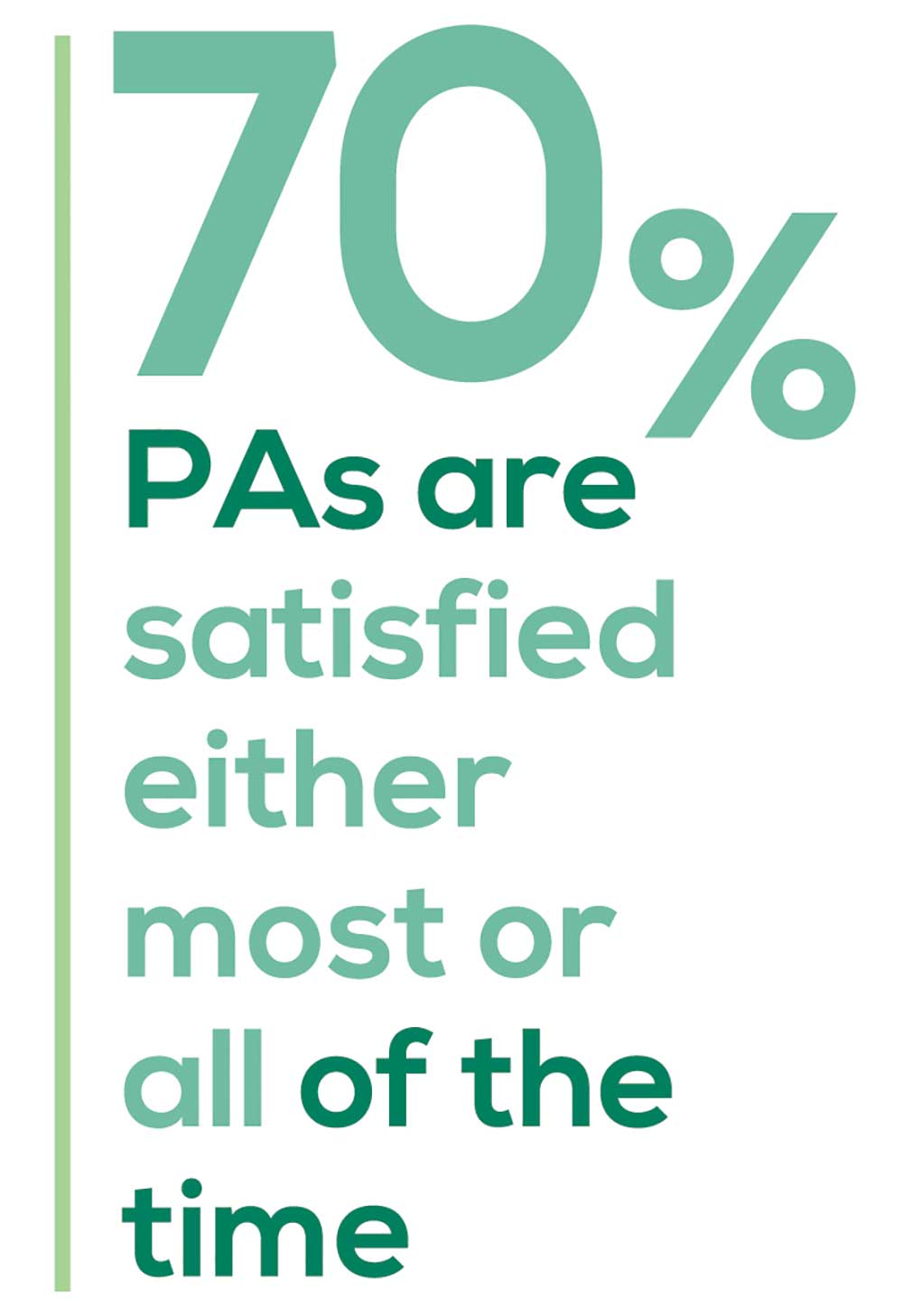
“I have the best job in the world.” This statement sums up how your colleagues feel about being a PA. Although there are certainly problems that deserve attention, the vast majority of clinicians, who are highly educated and practice in all specialties, state that they would re-enter the field if choosing again.
On the following pages, we focus on the details of the survey results, with breakouts by specialty, region, and practice setting. Be sure to check out which benefits your colleagues are getting, how much they’re being reimbursed for continuing medical education, information about salary by gender and time spent during the workweek, and much more. Participants, invited to comment, have provided several illuminating quotes, which we’ve included throughout the article, indicating what it’s like to be “in the trenches.”
WOULD YOU REPEAT THIS?
To get to the heart of the matter, we asked our survey takers “If you were to do it again, would you choose…”
- The same career
- The same educational preparation
- The same practice setting
To see what your colleagues said, go to the next page

The majority of your peers gave an enthusiastic thumbs up to PA practice as a profession choice. Knowing what you know now, 86% of you agreed that you would follow the same career path today as when you entered practice, which is up 5% from last year.
Educational preparation came in for a ringing endorsement, increasing since last year’s survey results (a 3% increase), and practice setting remained virtually the same.
Of PAs in practice between < 1 and 5 years, 94% felt their educational training was adequate; 53% felt their current responsibilities matched their expectations accurately; and 74% said their career expectations were met.
WOULD YOU TAKE A NEW JOB TODAY?
Continuing to probe about your level of satisfaction, we asked how you feel about changing your job. The answer choices were, “I would…”
- Change my job if I could get a better one (ie, better paid)
- Take any other job in which I could earn as much as I do now (ie, Yes, to leave the profession)
- Change both my job and my occupation (ie, I am burned out)
- Not make any changes (ie, No, not for any reason)
We also asked you how many times you’ve changed jobs since graduating from your PA program. The 4 answer choices ranged from “None” to “More than 3 times.” The final question asked which factors influence your decision about seeking/accepting a new position, allowing more than one choice from the list below.
- Salary/compensation
- Options for supplemental income
- Greater independence/more autonomy
- Opportunities for professional growth/development
- Formal career ladder for advancement
- Defined career path
- Recognition and appreciation
- Schedule flexibility
- Geographic location
- Access to and subsidy for more educational opportunities
- Employer reimbursement of school loans
- Specific state scope of practice and licensure law
- Work-life balance, including addressing burnout
- Working conditions
- Avoid toxic coworkers
- Top-of-the-line tools
- Telecommuting
- Cost of living
- Opportunity for outdoor activities/lifestyle
To see what your colleagues said, go to the next page
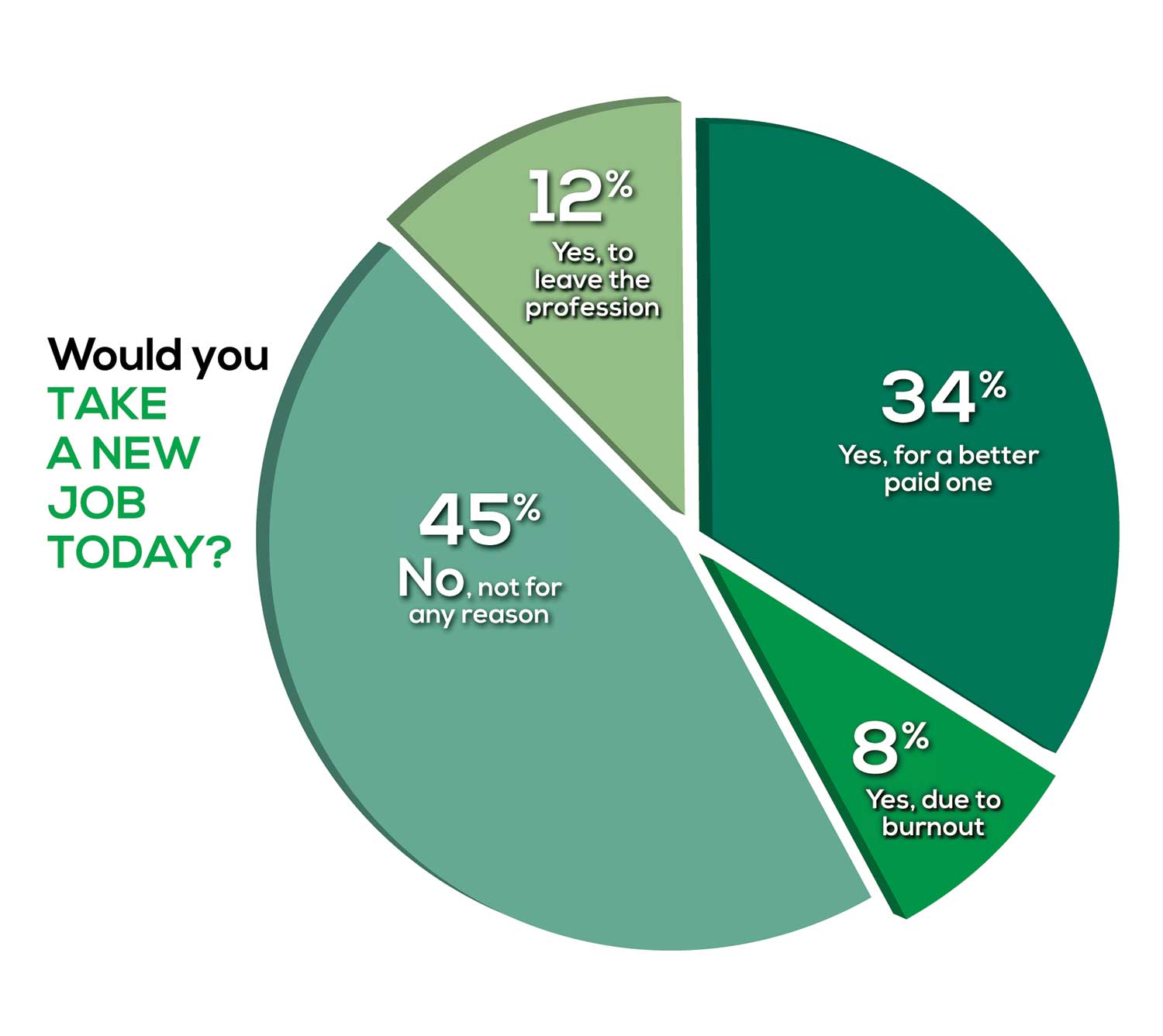
Compared to last year, PAs are 4% more likely to stay with their current job, stating that they would not make any changes, with 4% less likely to leave even if a higher salary were on offer. This is supported by the responses that indicate a fewer number of PAs (27%) have changed jobs at the highest rate (> 3 times) compared to 31% last year.
Although 19% of PAs have never changed jobs, 33% have changed 2 or 3 times, and 27% have changed more 3 times (down 4% from last year). However, more PAs report feeling burned out (up 2% from last year) and wish to leave for another profession (up 6% from last year) compared to last year.
Respondents indicated that the following 4 factors would strongly influence their decision to seek or accept a new position:
- Salary/compensation: 84%
- Work-life balance: 72%
- Schedule flexibility: 68%
- Working conditions: 64%
WHAT MAKES YOU MOST SATISFIED WITH YOUR WORK?
As you are aware, level of satisfaction depends on each of the following, which we asked respondents to rank from 1 to 5.
- Relationships with your colleagues (health care providers and clerical/administrative personnel)
- Quality and duration of patient relationships
- Respect received from patients, their families, and your community
- Ability to make a difference and provide significant help to patients, their families, and your community
To see what your colleagues said, go to the next page

Echoing the survey results—which ranked “Making a difference and providing significant help” as the topmost source of job satisfaction—one of your colleagues commented that, “Ability to offer meaningful support to client needs” affected their satisfaction. On the other hand, though, one clinician wrote, “I am starting to decrease my time in urgent care because I’m seeing more often that administration thinks we are selling a good, not a service—and because of lack of respect by patients as well.”
Compared to last year, the changes in response are
3% decrease: Making a difference and providing significant help
No change: Respect received from patients and their families
6% increase: Relationships with your colleagues
2% increase: Quality and duration of patient relationships
MOST SATISFIED BY SPECIALTY
Knowing that certain specialties offer more advantages than others, we presented a list of 19 medical specialties, asking which is your primary one. We also asked how often you typically feel satisfied with your job, with these answer choices.
- Never
- Occasionally
- About half the time
- Most of the time
- Always
To see what your colleagues said, go to the next page
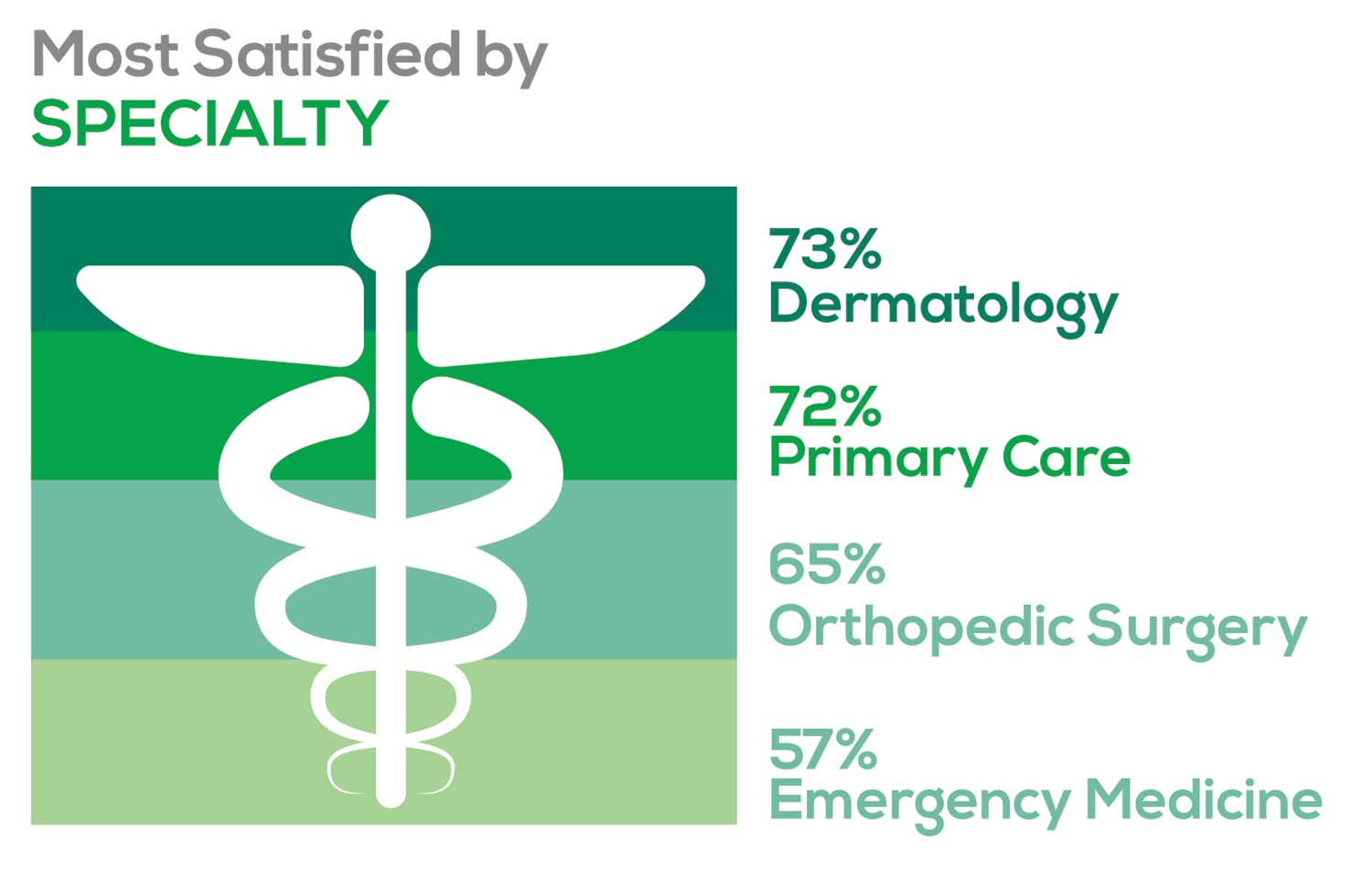
- Dermatology: 73%, a 9% decrease over last year
- Primary Care: 72%, virtually unchanged from last year
- Orthopedic Surgery: 65%, a new entry this year
- Emergency Medicine: 57%, an 8% decrease over last year
As one clinician commented, being “First assistant in surgery” makes a difference in their job satisfaction.
MOST SATISFIED BY PRACTICE SETTING
Working conditions and coworker collegiality are integral to job satisfaction. To learn more about these factors, we asked you to identify the practice settings where you work.
- Academic setting (faculty); school/college health services
- Hospital: inpatient care; outpatient setting or community clinic
- Locum
- Physician practice: solo; single-specialty; multi-specialty
- Public health/occupational health setting; military/government
- Retail/convenient care; urgent care clinic
- Skilled nursing/long-term care facility
We also asked how often you typically feel satisfied with your job, with 5 answer choices ranging from “Never” to “Always.”
To see what your colleagues said, go to the next page
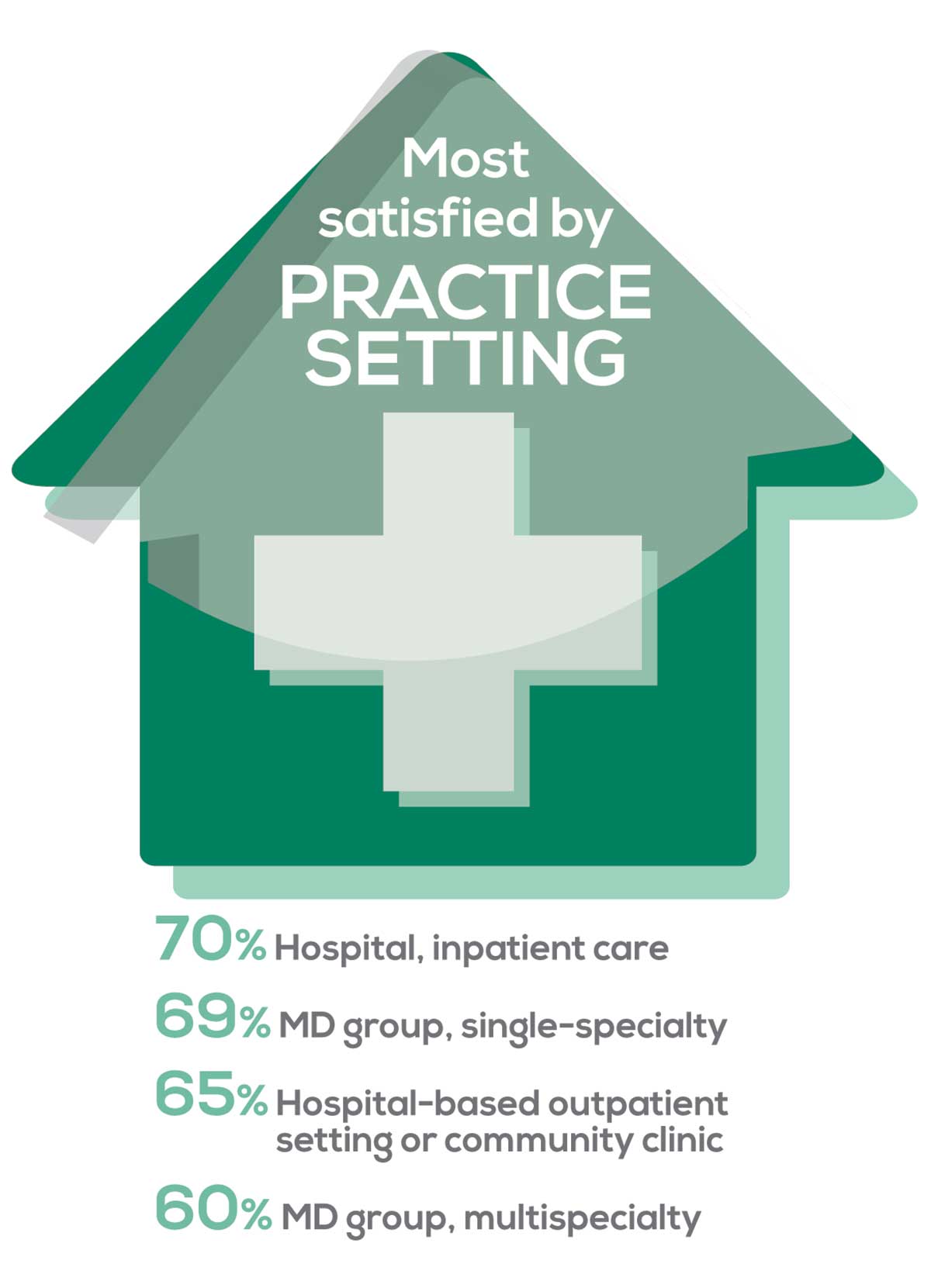
95% of PA respondents work as an employee; of these, 41% work in hospitals, and 31% work in physician offices.1 Therefore, it is gratifying to see that hospital settings and physician groups are satisfying places to work. In addition, this data has not changed significantly since last year.
- US Department of Health and Human Services, Health Resources and Services Administration, The U.S. Health Workforce Chartbook. Rockville, Maryland: U.S. Department of Health and Human Services, 2018.
BENEFITS
As you are aware, having access to the right benefits can go a long way to increasing job satisfaction. In addition to salary as a choice, we listed 30 benefits choices—insurance coverage, additional compensation opportunities, reimbursements, and other—asking which are offered by your employer (access) and which, in lieu of a modest increase in salary, are most important regardless of access. Your responses allowed us to identify the top 7 among your peers.
To see what your colleagues said, go to the next page
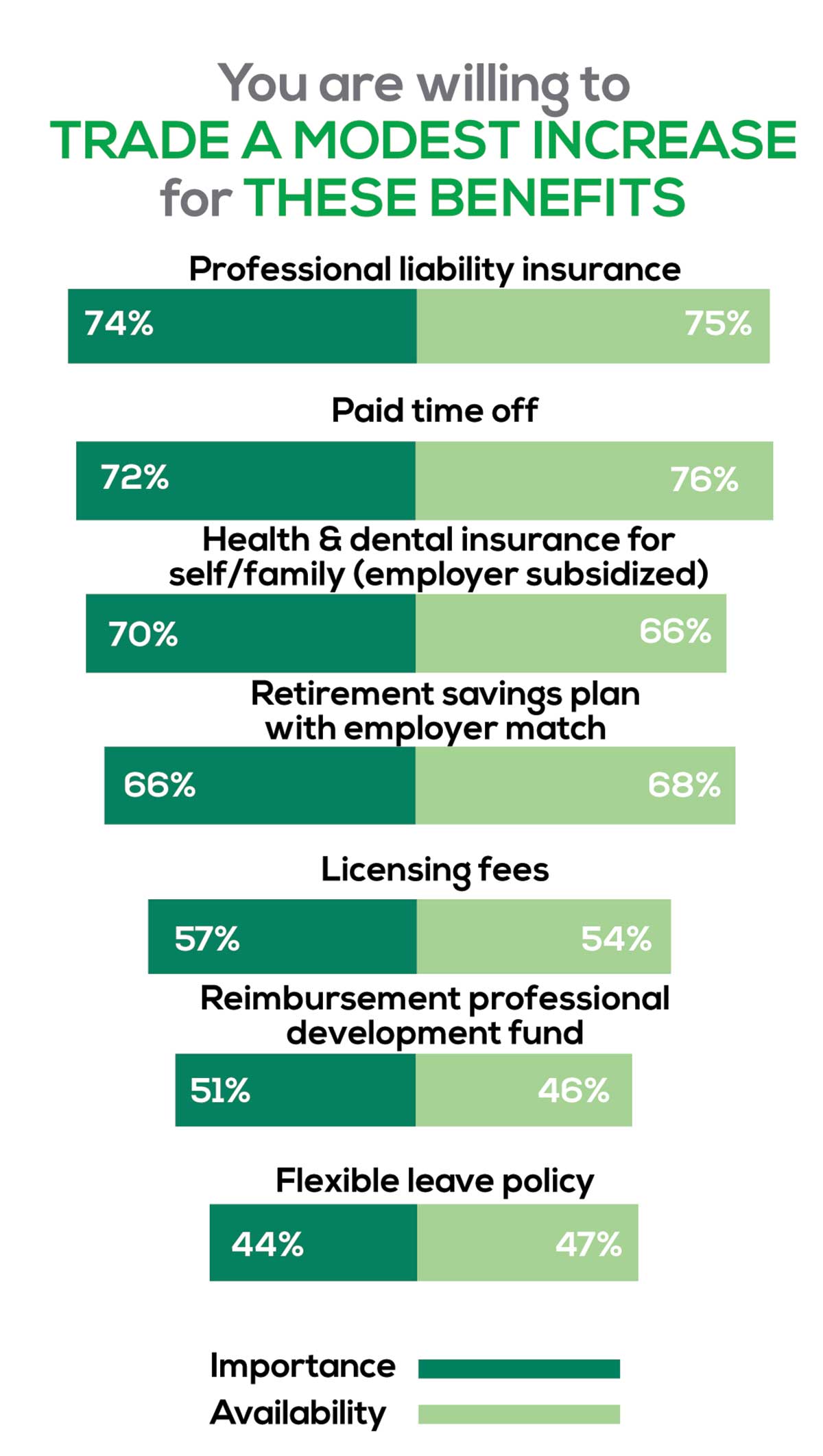
You are willing to trade a modest increase in salary for the following important benefits whether you are a new job seeker or an experienced practitioner.
- Compensation: Paid time off, retirement saving plan with employer match
- Insurance coverage: Professional liability insurance, health & dental insurance for self/family (employer subsidized)
- Reimbursements: Licensing fees, professional development fund
- Other: Flexible leave policy
MOST SATISFIED BY REGION
Location, location, location. Where you work depends in part on where your family is; in part on what jobs are available; what affects your commute, taxes and take home pay; and hence your satisfaction. So, we asked where you work—West, Midwest, Northeast, or South—and paired the data with responses to the question about how often you typically feel satisfied with your job, with 5 answer choices ranging from “Never” to “Always.”
To see what your colleagues said, go to the next page
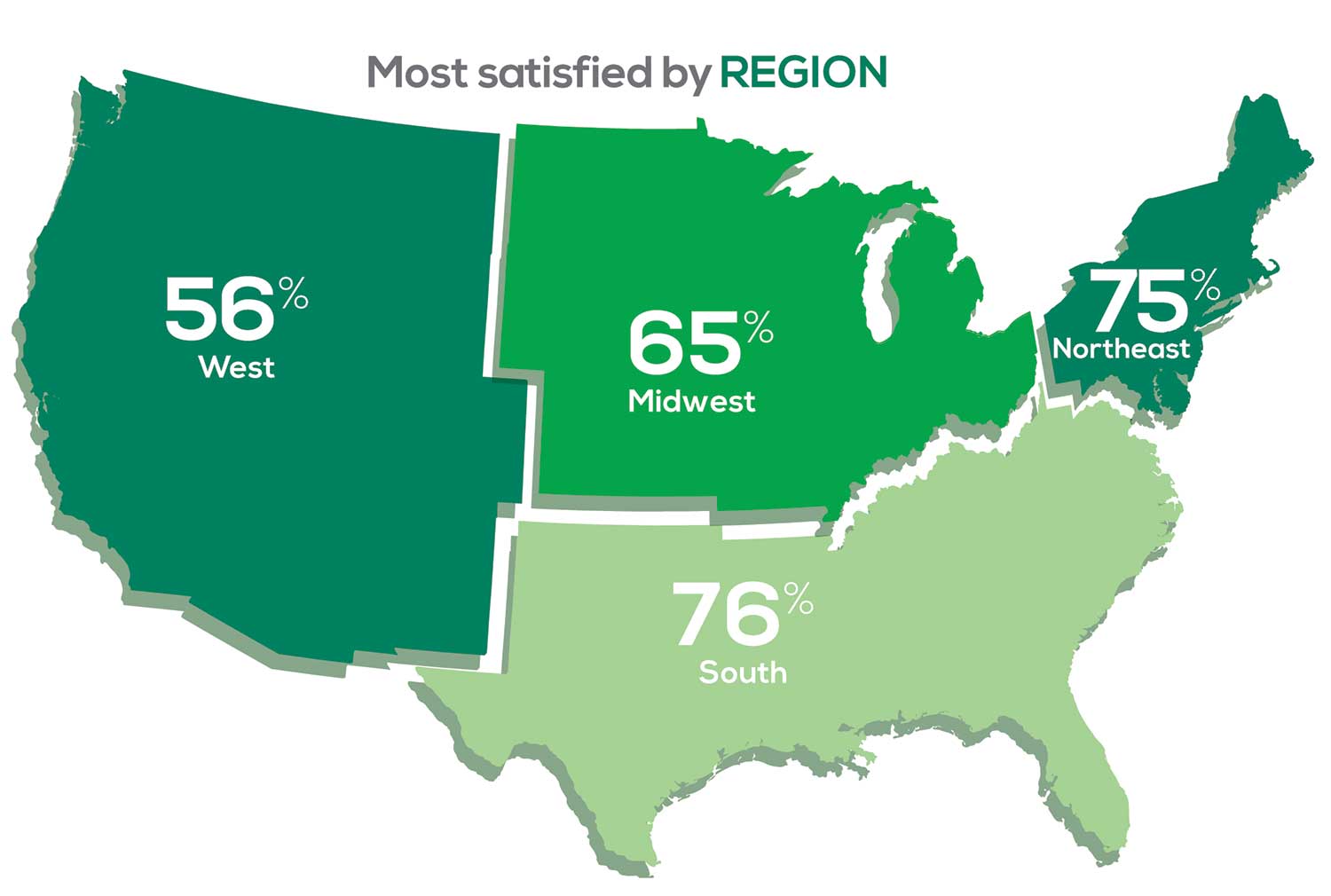
Geographic location is among the factors that influence the decision about seeking or accepting a new job for 53% of PA respondents. Compared to last year, satisfaction levels by region were
- 7% higher than last year in the Northeast
- 5% higher than last year in the South
- 12% lower than last year in the Midwest
- 17% lower than last year in the West
with 27% of PAs practicing in the Northeast; 32% in the South; 21% in the Midwest, and 19% in the West. 76% of PAs working in the South are “most of the time/always” satisfied with their job.
When base salaries are adjusted for cost of living, the top 10 ranked states are, from first to 10th, Oklahoma, Arkansas, Ohio, Texas, Michigan, Indiana, Iowa, New Mexico, Mississippi, and South Dakota.1
- American Academy of PAs. 2019 AAPA Salary Report. Alexandria, VA; 2019.
SALARY
Because you indicated that salary is second in importance only to professional liability insurance coverage as part of a desirable compensation package, we asked you to tell us what your salary bracket is. The amounts ranged from < $50,000 to > $175,000 per year (in $25,000 increments). Combining the responses to this question with those asking about gender and specialty, we are able to tie these factors together for you.
To see what your colleagues said, go to the next page
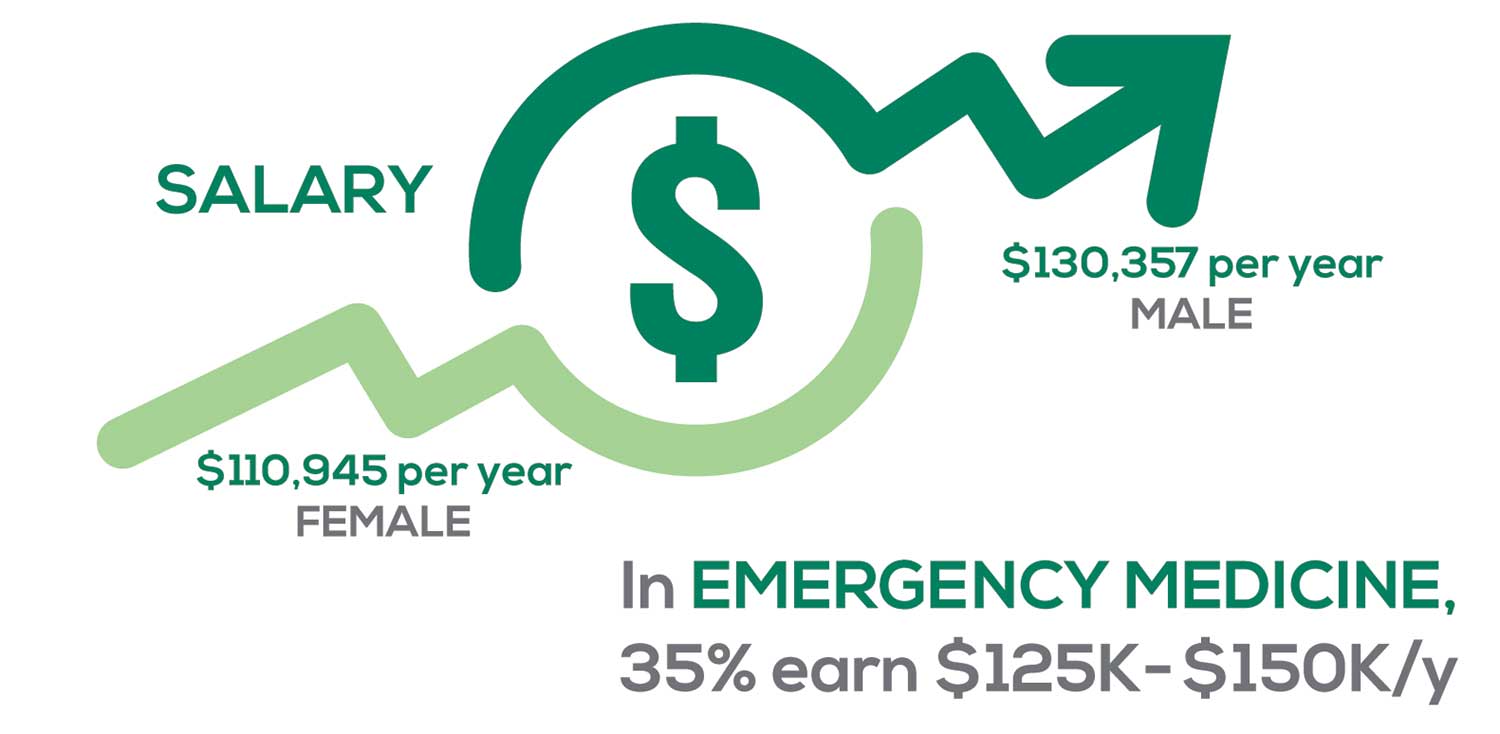
Approximately 5% of PAs earn $50K to $75K per year; 36%, earn $100K to $125K per year; and 5% earn > $175K per year. Similar to responses of previous years, women earn less than men in the PA profession.
PAs practicing in Emergency Medicine (EM) are the most highly compensated, with their median compensation being almost $117K.1 In fact, among those in EM, we found that 35% earn between $125K and $150K per year, up from 27% from last year. Clinicians working in the emergency room encounter more stressors (a clinician noted “Abuse of the emergency room by patients with ridiculous complaints” as a source of dissatisfaction) than those encountered in other specialties, which may be related to the higher compensation.
Although most PAs feel they are adequately compensated, we found that of those who practice in Family Medicine, 19% earn less than $75K per year, up from 6% from last year.
- American Academy of PAs. 2019 AAPA Salary Report. Alexandria, VA; 2019.
WORKWEEK
Job satisfaction, and its opposite, burnout are related to your workload (ie, what you do and how much autonomy you have in deciding how to proceed). To help us evaluate these factors, we asked your colleagues to indicate how many hours per week are typically spent in direct (examine/diagnose/treat) and indirect patient care (perform and interpret labs, x-rays, refill prescriptions, etc.), administrative duties, meetings, and teaching.
We were also interested in whether you assess, treat, and manage decisions
- Independently/by yourself
- In direct contact (in person or by phone) with a collaborating physician
- In consultation with a specialist when providing patient care.
Multiple answer choices were permitted.
To see what your colleagues said, go to the next page
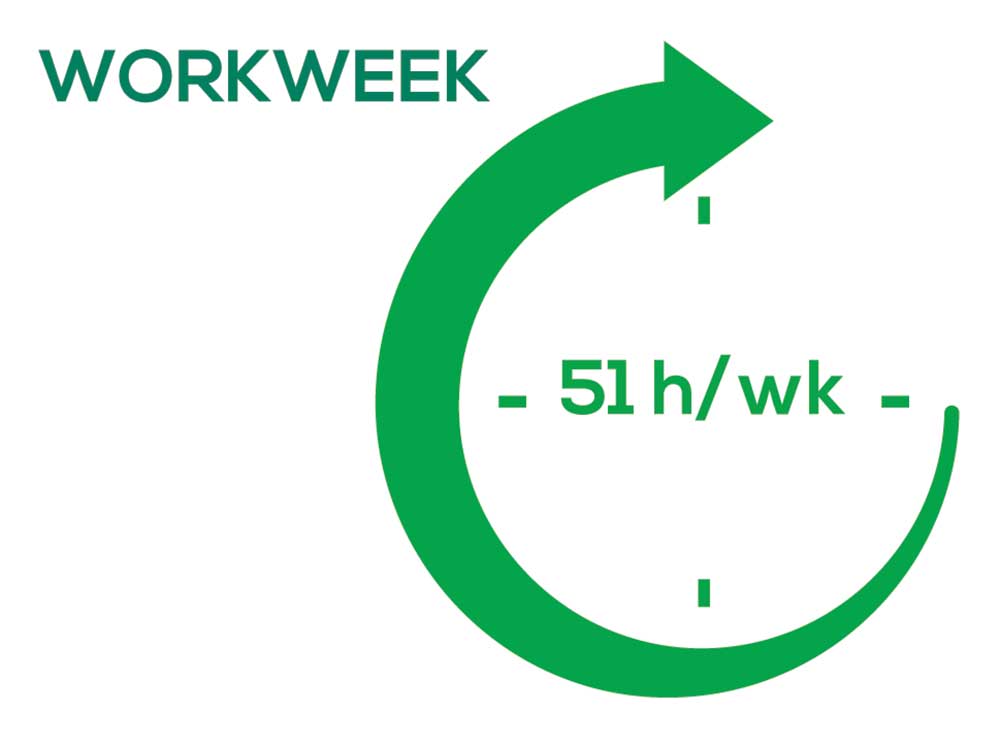
As you can imagine, workload is a very hot topic. In response to, “What else affects your job satisfaction?” the greatest number of comments related to electronic charting and data collection. These activities are felt to demand so much time and effort that it takes away from patient care. The survey responses support this: Compared to last year, although the number of hours worked is the same this year, PAs now spend 1 hour less per week on patient care (direct and indirect) and 1 hour more on other duties (administrative and teaching). As one clinician put it, “…availability of medical assistant/administrative support is huge” in alleviating the sense of being overworked or overextended.
Aside from work hours, clinicians told us they seek positions that allow them “input on all issues related to practice” and flexibility on “what/who I am allowed to treat.” According to the survey, when providing patient care,
- 84% of PAs assess, treat, and manage decisions independently
- 37% collaborate with a physician
- 19% consult with a specialist
supporting the fact that 58% of PAs are satisfied most of the time; 12% are always satisfied.
A side note: Of the 50% of PAs who responded that they are involved in teaching students (78% of whom are PAs), they spend approximately 4 hours a week,
- Either as a clinical preceptor (35%)
- In the classroom (5%)
- Or both (10%).
CME REIMBURSEMENT
As we know, PAs earn continuing medical education (CME) credits in order to maintain certification. Therefore, we asked you to indicate how much financial reimbursement you receive annually for CME; answer choices range from $0 to > $2,000 per year (in $500 increments). We also queried you about how much time you are allotted annually for CME; choices were from “None” to “More than 5 weeks.”
To see what your colleagues said, go to the next page
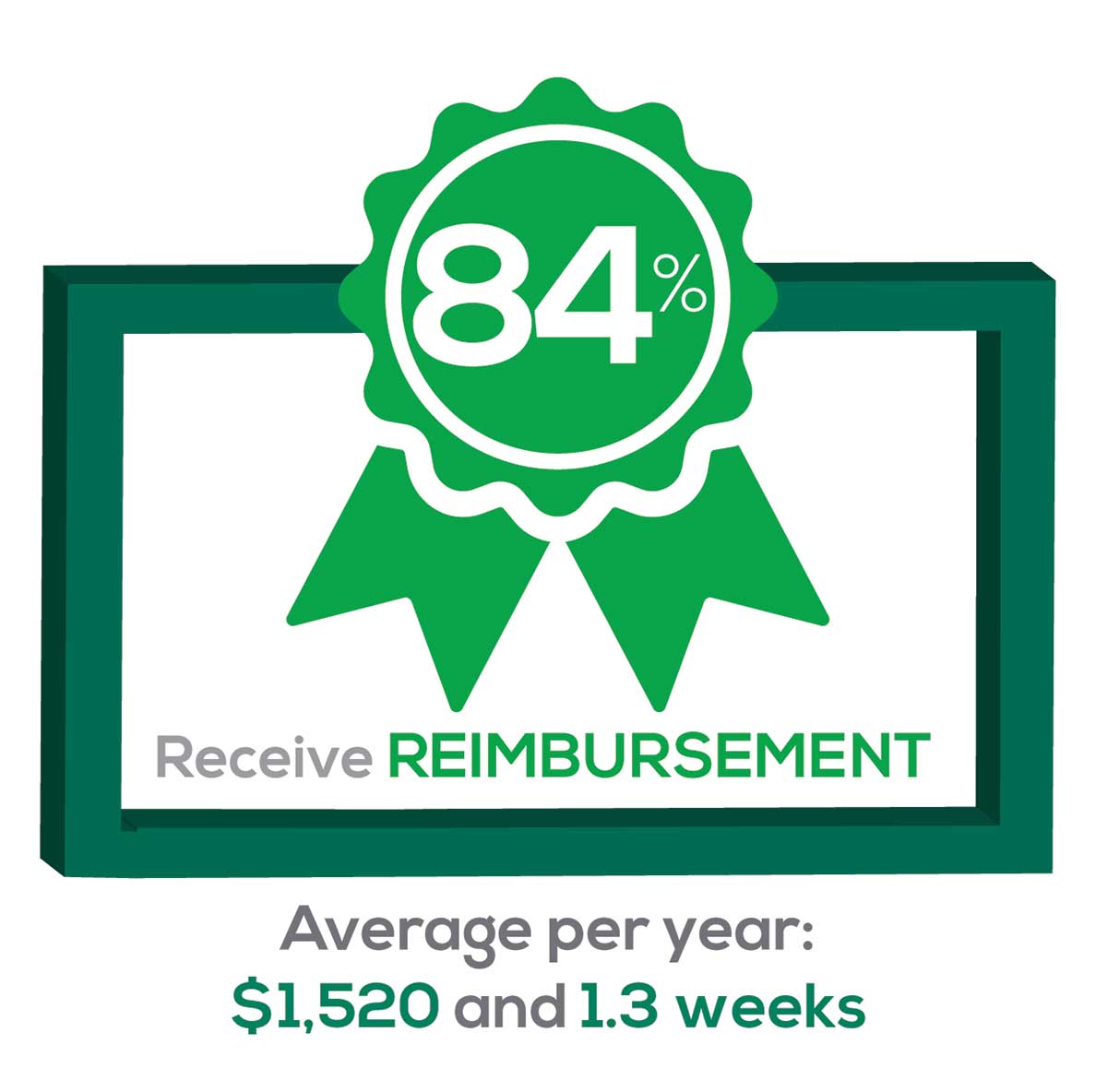
Many of your colleagues responded to the question “What else affects your job satisfaction?” with “Support for continuing learning” and “Educational opportunities.” This is reflected by 51% of survey respondents who stated that “Reimbursement for professional development” was an important benefit (see “Top 7 Benefits” above).
This year, 84% of respondents reported receiving remuneration—either money or time allowed or both—for CME, down 3% from last year. Specifically,
- 16% received $0
- 6%, less than $500
- 10%, between $500 - $1,000
- 25%, between $1,001 - $1,500
- 19%, between $1,501 - $2,000
- 24%, more than $2,000
with average monetary compensation per year up approximately $200 over last year.
Responses to the amount of time you are allotted annually for CME ranged from “None” to “more than 5 weeks.”
- 25%, no time
- 31%, less than 1 week
- 38%, 1-2 weeks
- 3%, 3 weeks
- 1%, 4 weeks
- 0.25%, 5 weeks
- 1%, more than 5 weeks.
In closing, we offer thanks to all the survey participants whose answers helped us understand your current state of job satisfaction and most especially for your frank and enlightening responses to the open-ended questions.
METHODOLOGY
Fielded electronically under the Clinician Reviews logo, an introductory email letter signed by the Editors-in-Chief invited participation in the online 4th annual NP/PA Job Satisfaction Survey of 35 questions.
The survey was fielded August 23, 2019 to a random representative sample of NPs and PAs within the United States, excluding students. The first 150 respondents to complete the survey received a $25 Amazon.com gift certificate.
A total of 1,323 usable responses—a projectable sample size—were received by October 3, 2019, the final cut-off date.
Of the total respondents, 70% are NPs (931) and 30% are PAs (396), which is proportional to the universe of NPs and PAs.1,2 This summary of results is based on only those respondents who designated their profession as NP or PA.
- American Association of Nurse Practitioners. NP Fact Sheet. www.aanp.org/all-about-nps/np-fact-sheet. Accessed November 22, 2019.
- NCCPA. 2018 Statistical Profile of Certified Physician Assistants: an Annual Report of the National Commission on Certification of Physician Assistants. https://prodcmsstoragesa.blob.core.windows.net/uploads/files/2018StatisticalProfileofCertifiedPhysicianAssistants.pdf. Accessed November 22, 2019.
1. American Association of Nurse Practitioners. NP Fact Sheet. www.aanp.org/all-about-nps/np-fact-sheet. Accessed November 22, 2019.
2. NCCPA. 2018 Statistical Profile of Certified Physician Assistants: an Annual Report of the National Commission on Certification of Physician Assistants. https://prodcmsstoragesa.blob.core.windows.net/uploads/files/2018StatisticalProfileofCertifiedPhysicianAssistants.pdf. Accessed November 22, 2019.

“I have the best job in the world.” This statement sums up how your colleagues feel about being a PA. Although there are certainly problems that deserve attention, the vast majority of clinicians, who are highly educated and practice in all specialties, state that they would re-enter the field if choosing again.
On the following pages, we focus on the details of the survey results, with breakouts by specialty, region, and practice setting. Be sure to check out which benefits your colleagues are getting, how much they’re being reimbursed for continuing medical education, information about salary by gender and time spent during the workweek, and much more. Participants, invited to comment, have provided several illuminating quotes, which we’ve included throughout the article, indicating what it’s like to be “in the trenches.”
WOULD YOU REPEAT THIS?
To get to the heart of the matter, we asked our survey takers “If you were to do it again, would you choose…”
- The same career
- The same educational preparation
- The same practice setting
To see what your colleagues said, go to the next page

The majority of your peers gave an enthusiastic thumbs up to PA practice as a profession choice. Knowing what you know now, 86% of you agreed that you would follow the same career path today as when you entered practice, which is up 5% from last year.
Educational preparation came in for a ringing endorsement, increasing since last year’s survey results (a 3% increase), and practice setting remained virtually the same.
Of PAs in practice between < 1 and 5 years, 94% felt their educational training was adequate; 53% felt their current responsibilities matched their expectations accurately; and 74% said their career expectations were met.
WOULD YOU TAKE A NEW JOB TODAY?
Continuing to probe about your level of satisfaction, we asked how you feel about changing your job. The answer choices were, “I would…”
- Change my job if I could get a better one (ie, better paid)
- Take any other job in which I could earn as much as I do now (ie, Yes, to leave the profession)
- Change both my job and my occupation (ie, I am burned out)
- Not make any changes (ie, No, not for any reason)
We also asked you how many times you’ve changed jobs since graduating from your PA program. The 4 answer choices ranged from “None” to “More than 3 times.” The final question asked which factors influence your decision about seeking/accepting a new position, allowing more than one choice from the list below.
- Salary/compensation
- Options for supplemental income
- Greater independence/more autonomy
- Opportunities for professional growth/development
- Formal career ladder for advancement
- Defined career path
- Recognition and appreciation
- Schedule flexibility
- Geographic location
- Access to and subsidy for more educational opportunities
- Employer reimbursement of school loans
- Specific state scope of practice and licensure law
- Work-life balance, including addressing burnout
- Working conditions
- Avoid toxic coworkers
- Top-of-the-line tools
- Telecommuting
- Cost of living
- Opportunity for outdoor activities/lifestyle
To see what your colleagues said, go to the next page

Compared to last year, PAs are 4% more likely to stay with their current job, stating that they would not make any changes, with 4% less likely to leave even if a higher salary were on offer. This is supported by the responses that indicate a fewer number of PAs (27%) have changed jobs at the highest rate (> 3 times) compared to 31% last year.
Although 19% of PAs have never changed jobs, 33% have changed 2 or 3 times, and 27% have changed more 3 times (down 4% from last year). However, more PAs report feeling burned out (up 2% from last year) and wish to leave for another profession (up 6% from last year) compared to last year.
Respondents indicated that the following 4 factors would strongly influence their decision to seek or accept a new position:
- Salary/compensation: 84%
- Work-life balance: 72%
- Schedule flexibility: 68%
- Working conditions: 64%
WHAT MAKES YOU MOST SATISFIED WITH YOUR WORK?
As you are aware, level of satisfaction depends on each of the following, which we asked respondents to rank from 1 to 5.
- Relationships with your colleagues (health care providers and clerical/administrative personnel)
- Quality and duration of patient relationships
- Respect received from patients, their families, and your community
- Ability to make a difference and provide significant help to patients, their families, and your community
To see what your colleagues said, go to the next page

Echoing the survey results—which ranked “Making a difference and providing significant help” as the topmost source of job satisfaction—one of your colleagues commented that, “Ability to offer meaningful support to client needs” affected their satisfaction. On the other hand, though, one clinician wrote, “I am starting to decrease my time in urgent care because I’m seeing more often that administration thinks we are selling a good, not a service—and because of lack of respect by patients as well.”
Compared to last year, the changes in response are
3% decrease: Making a difference and providing significant help
No change: Respect received from patients and their families
6% increase: Relationships with your colleagues
2% increase: Quality and duration of patient relationships
MOST SATISFIED BY SPECIALTY
Knowing that certain specialties offer more advantages than others, we presented a list of 19 medical specialties, asking which is your primary one. We also asked how often you typically feel satisfied with your job, with these answer choices.
- Never
- Occasionally
- About half the time
- Most of the time
- Always
To see what your colleagues said, go to the next page

- Dermatology: 73%, a 9% decrease over last year
- Primary Care: 72%, virtually unchanged from last year
- Orthopedic Surgery: 65%, a new entry this year
- Emergency Medicine: 57%, an 8% decrease over last year
As one clinician commented, being “First assistant in surgery” makes a difference in their job satisfaction.
MOST SATISFIED BY PRACTICE SETTING
Working conditions and coworker collegiality are integral to job satisfaction. To learn more about these factors, we asked you to identify the practice settings where you work.
- Academic setting (faculty); school/college health services
- Hospital: inpatient care; outpatient setting or community clinic
- Locum
- Physician practice: solo; single-specialty; multi-specialty
- Public health/occupational health setting; military/government
- Retail/convenient care; urgent care clinic
- Skilled nursing/long-term care facility
We also asked how often you typically feel satisfied with your job, with 5 answer choices ranging from “Never” to “Always.”
To see what your colleagues said, go to the next page

95% of PA respondents work as an employee; of these, 41% work in hospitals, and 31% work in physician offices.1 Therefore, it is gratifying to see that hospital settings and physician groups are satisfying places to work. In addition, this data has not changed significantly since last year.
- US Department of Health and Human Services, Health Resources and Services Administration, The U.S. Health Workforce Chartbook. Rockville, Maryland: U.S. Department of Health and Human Services, 2018.
BENEFITS
As you are aware, having access to the right benefits can go a long way to increasing job satisfaction. In addition to salary as a choice, we listed 30 benefits choices—insurance coverage, additional compensation opportunities, reimbursements, and other—asking which are offered by your employer (access) and which, in lieu of a modest increase in salary, are most important regardless of access. Your responses allowed us to identify the top 7 among your peers.
To see what your colleagues said, go to the next page

You are willing to trade a modest increase in salary for the following important benefits whether you are a new job seeker or an experienced practitioner.
- Compensation: Paid time off, retirement saving plan with employer match
- Insurance coverage: Professional liability insurance, health & dental insurance for self/family (employer subsidized)
- Reimbursements: Licensing fees, professional development fund
- Other: Flexible leave policy
MOST SATISFIED BY REGION
Location, location, location. Where you work depends in part on where your family is; in part on what jobs are available; what affects your commute, taxes and take home pay; and hence your satisfaction. So, we asked where you work—West, Midwest, Northeast, or South—and paired the data with responses to the question about how often you typically feel satisfied with your job, with 5 answer choices ranging from “Never” to “Always.”
To see what your colleagues said, go to the next page

Geographic location is among the factors that influence the decision about seeking or accepting a new job for 53% of PA respondents. Compared to last year, satisfaction levels by region were
- 7% higher than last year in the Northeast
- 5% higher than last year in the South
- 12% lower than last year in the Midwest
- 17% lower than last year in the West
with 27% of PAs practicing in the Northeast; 32% in the South; 21% in the Midwest, and 19% in the West. 76% of PAs working in the South are “most of the time/always” satisfied with their job.
When base salaries are adjusted for cost of living, the top 10 ranked states are, from first to 10th, Oklahoma, Arkansas, Ohio, Texas, Michigan, Indiana, Iowa, New Mexico, Mississippi, and South Dakota.1
- American Academy of PAs. 2019 AAPA Salary Report. Alexandria, VA; 2019.
SALARY
Because you indicated that salary is second in importance only to professional liability insurance coverage as part of a desirable compensation package, we asked you to tell us what your salary bracket is. The amounts ranged from < $50,000 to > $175,000 per year (in $25,000 increments). Combining the responses to this question with those asking about gender and specialty, we are able to tie these factors together for you.
To see what your colleagues said, go to the next page

Approximately 5% of PAs earn $50K to $75K per year; 36%, earn $100K to $125K per year; and 5% earn > $175K per year. Similar to responses of previous years, women earn less than men in the PA profession.
PAs practicing in Emergency Medicine (EM) are the most highly compensated, with their median compensation being almost $117K.1 In fact, among those in EM, we found that 35% earn between $125K and $150K per year, up from 27% from last year. Clinicians working in the emergency room encounter more stressors (a clinician noted “Abuse of the emergency room by patients with ridiculous complaints” as a source of dissatisfaction) than those encountered in other specialties, which may be related to the higher compensation.
Although most PAs feel they are adequately compensated, we found that of those who practice in Family Medicine, 19% earn less than $75K per year, up from 6% from last year.
- American Academy of PAs. 2019 AAPA Salary Report. Alexandria, VA; 2019.
WORKWEEK
Job satisfaction, and its opposite, burnout are related to your workload (ie, what you do and how much autonomy you have in deciding how to proceed). To help us evaluate these factors, we asked your colleagues to indicate how many hours per week are typically spent in direct (examine/diagnose/treat) and indirect patient care (perform and interpret labs, x-rays, refill prescriptions, etc.), administrative duties, meetings, and teaching.
We were also interested in whether you assess, treat, and manage decisions
- Independently/by yourself
- In direct contact (in person or by phone) with a collaborating physician
- In consultation with a specialist when providing patient care.
Multiple answer choices were permitted.
To see what your colleagues said, go to the next page

As you can imagine, workload is a very hot topic. In response to, “What else affects your job satisfaction?” the greatest number of comments related to electronic charting and data collection. These activities are felt to demand so much time and effort that it takes away from patient care. The survey responses support this: Compared to last year, although the number of hours worked is the same this year, PAs now spend 1 hour less per week on patient care (direct and indirect) and 1 hour more on other duties (administrative and teaching). As one clinician put it, “…availability of medical assistant/administrative support is huge” in alleviating the sense of being overworked or overextended.
Aside from work hours, clinicians told us they seek positions that allow them “input on all issues related to practice” and flexibility on “what/who I am allowed to treat.” According to the survey, when providing patient care,
- 84% of PAs assess, treat, and manage decisions independently
- 37% collaborate with a physician
- 19% consult with a specialist
supporting the fact that 58% of PAs are satisfied most of the time; 12% are always satisfied.
A side note: Of the 50% of PAs who responded that they are involved in teaching students (78% of whom are PAs), they spend approximately 4 hours a week,
- Either as a clinical preceptor (35%)
- In the classroom (5%)
- Or both (10%).
CME REIMBURSEMENT
As we know, PAs earn continuing medical education (CME) credits in order to maintain certification. Therefore, we asked you to indicate how much financial reimbursement you receive annually for CME; answer choices range from $0 to > $2,000 per year (in $500 increments). We also queried you about how much time you are allotted annually for CME; choices were from “None” to “More than 5 weeks.”
To see what your colleagues said, go to the next page

Many of your colleagues responded to the question “What else affects your job satisfaction?” with “Support for continuing learning” and “Educational opportunities.” This is reflected by 51% of survey respondents who stated that “Reimbursement for professional development” was an important benefit (see “Top 7 Benefits” above).
This year, 84% of respondents reported receiving remuneration—either money or time allowed or both—for CME, down 3% from last year. Specifically,
- 16% received $0
- 6%, less than $500
- 10%, between $500 - $1,000
- 25%, between $1,001 - $1,500
- 19%, between $1,501 - $2,000
- 24%, more than $2,000
with average monetary compensation per year up approximately $200 over last year.
Responses to the amount of time you are allotted annually for CME ranged from “None” to “more than 5 weeks.”
- 25%, no time
- 31%, less than 1 week
- 38%, 1-2 weeks
- 3%, 3 weeks
- 1%, 4 weeks
- 0.25%, 5 weeks
- 1%, more than 5 weeks.
In closing, we offer thanks to all the survey participants whose answers helped us understand your current state of job satisfaction and most especially for your frank and enlightening responses to the open-ended questions.
METHODOLOGY
Fielded electronically under the Clinician Reviews logo, an introductory email letter signed by the Editors-in-Chief invited participation in the online 4th annual NP/PA Job Satisfaction Survey of 35 questions.
The survey was fielded August 23, 2019 to a random representative sample of NPs and PAs within the United States, excluding students. The first 150 respondents to complete the survey received a $25 Amazon.com gift certificate.
A total of 1,323 usable responses—a projectable sample size—were received by October 3, 2019, the final cut-off date.
Of the total respondents, 70% are NPs (931) and 30% are PAs (396), which is proportional to the universe of NPs and PAs.1,2 This summary of results is based on only those respondents who designated their profession as NP or PA.
- American Association of Nurse Practitioners. NP Fact Sheet. www.aanp.org/all-about-nps/np-fact-sheet. Accessed November 22, 2019.
- NCCPA. 2018 Statistical Profile of Certified Physician Assistants: an Annual Report of the National Commission on Certification of Physician Assistants. https://prodcmsstoragesa.blob.core.windows.net/uploads/files/2018StatisticalProfileofCertifiedPhysicianAssistants.pdf. Accessed November 22, 2019.

“I have the best job in the world.” This statement sums up how your colleagues feel about being a PA. Although there are certainly problems that deserve attention, the vast majority of clinicians, who are highly educated and practice in all specialties, state that they would re-enter the field if choosing again.
On the following pages, we focus on the details of the survey results, with breakouts by specialty, region, and practice setting. Be sure to check out which benefits your colleagues are getting, how much they’re being reimbursed for continuing medical education, information about salary by gender and time spent during the workweek, and much more. Participants, invited to comment, have provided several illuminating quotes, which we’ve included throughout the article, indicating what it’s like to be “in the trenches.”
WOULD YOU REPEAT THIS?
To get to the heart of the matter, we asked our survey takers “If you were to do it again, would you choose…”
- The same career
- The same educational preparation
- The same practice setting
To see what your colleagues said, go to the next page

The majority of your peers gave an enthusiastic thumbs up to PA practice as a profession choice. Knowing what you know now, 86% of you agreed that you would follow the same career path today as when you entered practice, which is up 5% from last year.
Educational preparation came in for a ringing endorsement, increasing since last year’s survey results (a 3% increase), and practice setting remained virtually the same.
Of PAs in practice between < 1 and 5 years, 94% felt their educational training was adequate; 53% felt their current responsibilities matched their expectations accurately; and 74% said their career expectations were met.
WOULD YOU TAKE A NEW JOB TODAY?
Continuing to probe about your level of satisfaction, we asked how you feel about changing your job. The answer choices were, “I would…”
- Change my job if I could get a better one (ie, better paid)
- Take any other job in which I could earn as much as I do now (ie, Yes, to leave the profession)
- Change both my job and my occupation (ie, I am burned out)
- Not make any changes (ie, No, not for any reason)
We also asked you how many times you’ve changed jobs since graduating from your PA program. The 4 answer choices ranged from “None” to “More than 3 times.” The final question asked which factors influence your decision about seeking/accepting a new position, allowing more than one choice from the list below.
- Salary/compensation
- Options for supplemental income
- Greater independence/more autonomy
- Opportunities for professional growth/development
- Formal career ladder for advancement
- Defined career path
- Recognition and appreciation
- Schedule flexibility
- Geographic location
- Access to and subsidy for more educational opportunities
- Employer reimbursement of school loans
- Specific state scope of practice and licensure law
- Work-life balance, including addressing burnout
- Working conditions
- Avoid toxic coworkers
- Top-of-the-line tools
- Telecommuting
- Cost of living
- Opportunity for outdoor activities/lifestyle
To see what your colleagues said, go to the next page

Compared to last year, PAs are 4% more likely to stay with their current job, stating that they would not make any changes, with 4% less likely to leave even if a higher salary were on offer. This is supported by the responses that indicate a fewer number of PAs (27%) have changed jobs at the highest rate (> 3 times) compared to 31% last year.
Although 19% of PAs have never changed jobs, 33% have changed 2 or 3 times, and 27% have changed more 3 times (down 4% from last year). However, more PAs report feeling burned out (up 2% from last year) and wish to leave for another profession (up 6% from last year) compared to last year.
Respondents indicated that the following 4 factors would strongly influence their decision to seek or accept a new position:
- Salary/compensation: 84%
- Work-life balance: 72%
- Schedule flexibility: 68%
- Working conditions: 64%
WHAT MAKES YOU MOST SATISFIED WITH YOUR WORK?
As you are aware, level of satisfaction depends on each of the following, which we asked respondents to rank from 1 to 5.
- Relationships with your colleagues (health care providers and clerical/administrative personnel)
- Quality and duration of patient relationships
- Respect received from patients, their families, and your community
- Ability to make a difference and provide significant help to patients, their families, and your community
To see what your colleagues said, go to the next page

Echoing the survey results—which ranked “Making a difference and providing significant help” as the topmost source of job satisfaction—one of your colleagues commented that, “Ability to offer meaningful support to client needs” affected their satisfaction. On the other hand, though, one clinician wrote, “I am starting to decrease my time in urgent care because I’m seeing more often that administration thinks we are selling a good, not a service—and because of lack of respect by patients as well.”
Compared to last year, the changes in response are
3% decrease: Making a difference and providing significant help
No change: Respect received from patients and their families
6% increase: Relationships with your colleagues
2% increase: Quality and duration of patient relationships
MOST SATISFIED BY SPECIALTY
Knowing that certain specialties offer more advantages than others, we presented a list of 19 medical specialties, asking which is your primary one. We also asked how often you typically feel satisfied with your job, with these answer choices.
- Never
- Occasionally
- About half the time
- Most of the time
- Always
To see what your colleagues said, go to the next page

- Dermatology: 73%, a 9% decrease over last year
- Primary Care: 72%, virtually unchanged from last year
- Orthopedic Surgery: 65%, a new entry this year
- Emergency Medicine: 57%, an 8% decrease over last year
As one clinician commented, being “First assistant in surgery” makes a difference in their job satisfaction.
MOST SATISFIED BY PRACTICE SETTING
Working conditions and coworker collegiality are integral to job satisfaction. To learn more about these factors, we asked you to identify the practice settings where you work.
- Academic setting (faculty); school/college health services
- Hospital: inpatient care; outpatient setting or community clinic
- Locum
- Physician practice: solo; single-specialty; multi-specialty
- Public health/occupational health setting; military/government
- Retail/convenient care; urgent care clinic
- Skilled nursing/long-term care facility
We also asked how often you typically feel satisfied with your job, with 5 answer choices ranging from “Never” to “Always.”
To see what your colleagues said, go to the next page

95% of PA respondents work as an employee; of these, 41% work in hospitals, and 31% work in physician offices.1 Therefore, it is gratifying to see that hospital settings and physician groups are satisfying places to work. In addition, this data has not changed significantly since last year.
- US Department of Health and Human Services, Health Resources and Services Administration, The U.S. Health Workforce Chartbook. Rockville, Maryland: U.S. Department of Health and Human Services, 2018.
BENEFITS
As you are aware, having access to the right benefits can go a long way to increasing job satisfaction. In addition to salary as a choice, we listed 30 benefits choices—insurance coverage, additional compensation opportunities, reimbursements, and other—asking which are offered by your employer (access) and which, in lieu of a modest increase in salary, are most important regardless of access. Your responses allowed us to identify the top 7 among your peers.
To see what your colleagues said, go to the next page

You are willing to trade a modest increase in salary for the following important benefits whether you are a new job seeker or an experienced practitioner.
- Compensation: Paid time off, retirement saving plan with employer match
- Insurance coverage: Professional liability insurance, health & dental insurance for self/family (employer subsidized)
- Reimbursements: Licensing fees, professional development fund
- Other: Flexible leave policy
MOST SATISFIED BY REGION
Location, location, location. Where you work depends in part on where your family is; in part on what jobs are available; what affects your commute, taxes and take home pay; and hence your satisfaction. So, we asked where you work—West, Midwest, Northeast, or South—and paired the data with responses to the question about how often you typically feel satisfied with your job, with 5 answer choices ranging from “Never” to “Always.”
To see what your colleagues said, go to the next page

Geographic location is among the factors that influence the decision about seeking or accepting a new job for 53% of PA respondents. Compared to last year, satisfaction levels by region were
- 7% higher than last year in the Northeast
- 5% higher than last year in the South
- 12% lower than last year in the Midwest
- 17% lower than last year in the West
with 27% of PAs practicing in the Northeast; 32% in the South; 21% in the Midwest, and 19% in the West. 76% of PAs working in the South are “most of the time/always” satisfied with their job.
When base salaries are adjusted for cost of living, the top 10 ranked states are, from first to 10th, Oklahoma, Arkansas, Ohio, Texas, Michigan, Indiana, Iowa, New Mexico, Mississippi, and South Dakota.1
- American Academy of PAs. 2019 AAPA Salary Report. Alexandria, VA; 2019.
SALARY
Because you indicated that salary is second in importance only to professional liability insurance coverage as part of a desirable compensation package, we asked you to tell us what your salary bracket is. The amounts ranged from < $50,000 to > $175,000 per year (in $25,000 increments). Combining the responses to this question with those asking about gender and specialty, we are able to tie these factors together for you.
To see what your colleagues said, go to the next page

Approximately 5% of PAs earn $50K to $75K per year; 36%, earn $100K to $125K per year; and 5% earn > $175K per year. Similar to responses of previous years, women earn less than men in the PA profession.
PAs practicing in Emergency Medicine (EM) are the most highly compensated, with their median compensation being almost $117K.1 In fact, among those in EM, we found that 35% earn between $125K and $150K per year, up from 27% from last year. Clinicians working in the emergency room encounter more stressors (a clinician noted “Abuse of the emergency room by patients with ridiculous complaints” as a source of dissatisfaction) than those encountered in other specialties, which may be related to the higher compensation.
Although most PAs feel they are adequately compensated, we found that of those who practice in Family Medicine, 19% earn less than $75K per year, up from 6% from last year.
- American Academy of PAs. 2019 AAPA Salary Report. Alexandria, VA; 2019.
WORKWEEK
Job satisfaction, and its opposite, burnout are related to your workload (ie, what you do and how much autonomy you have in deciding how to proceed). To help us evaluate these factors, we asked your colleagues to indicate how many hours per week are typically spent in direct (examine/diagnose/treat) and indirect patient care (perform and interpret labs, x-rays, refill prescriptions, etc.), administrative duties, meetings, and teaching.
We were also interested in whether you assess, treat, and manage decisions
- Independently/by yourself
- In direct contact (in person or by phone) with a collaborating physician
- In consultation with a specialist when providing patient care.
Multiple answer choices were permitted.
To see what your colleagues said, go to the next page

As you can imagine, workload is a very hot topic. In response to, “What else affects your job satisfaction?” the greatest number of comments related to electronic charting and data collection. These activities are felt to demand so much time and effort that it takes away from patient care. The survey responses support this: Compared to last year, although the number of hours worked is the same this year, PAs now spend 1 hour less per week on patient care (direct and indirect) and 1 hour more on other duties (administrative and teaching). As one clinician put it, “…availability of medical assistant/administrative support is huge” in alleviating the sense of being overworked or overextended.
Aside from work hours, clinicians told us they seek positions that allow them “input on all issues related to practice” and flexibility on “what/who I am allowed to treat.” According to the survey, when providing patient care,
- 84% of PAs assess, treat, and manage decisions independently
- 37% collaborate with a physician
- 19% consult with a specialist
supporting the fact that 58% of PAs are satisfied most of the time; 12% are always satisfied.
A side note: Of the 50% of PAs who responded that they are involved in teaching students (78% of whom are PAs), they spend approximately 4 hours a week,
- Either as a clinical preceptor (35%)
- In the classroom (5%)
- Or both (10%).
CME REIMBURSEMENT
As we know, PAs earn continuing medical education (CME) credits in order to maintain certification. Therefore, we asked you to indicate how much financial reimbursement you receive annually for CME; answer choices range from $0 to > $2,000 per year (in $500 increments). We also queried you about how much time you are allotted annually for CME; choices were from “None” to “More than 5 weeks.”
To see what your colleagues said, go to the next page

Many of your colleagues responded to the question “What else affects your job satisfaction?” with “Support for continuing learning” and “Educational opportunities.” This is reflected by 51% of survey respondents who stated that “Reimbursement for professional development” was an important benefit (see “Top 7 Benefits” above).
This year, 84% of respondents reported receiving remuneration—either money or time allowed or both—for CME, down 3% from last year. Specifically,
- 16% received $0
- 6%, less than $500
- 10%, between $500 - $1,000
- 25%, between $1,001 - $1,500
- 19%, between $1,501 - $2,000
- 24%, more than $2,000
with average monetary compensation per year up approximately $200 over last year.
Responses to the amount of time you are allotted annually for CME ranged from “None” to “more than 5 weeks.”
- 25%, no time
- 31%, less than 1 week
- 38%, 1-2 weeks
- 3%, 3 weeks
- 1%, 4 weeks
- 0.25%, 5 weeks
- 1%, more than 5 weeks.
In closing, we offer thanks to all the survey participants whose answers helped us understand your current state of job satisfaction and most especially for your frank and enlightening responses to the open-ended questions.
METHODOLOGY
Fielded electronically under the Clinician Reviews logo, an introductory email letter signed by the Editors-in-Chief invited participation in the online 4th annual NP/PA Job Satisfaction Survey of 35 questions.
The survey was fielded August 23, 2019 to a random representative sample of NPs and PAs within the United States, excluding students. The first 150 respondents to complete the survey received a $25 Amazon.com gift certificate.
A total of 1,323 usable responses—a projectable sample size—were received by October 3, 2019, the final cut-off date.
Of the total respondents, 70% are NPs (931) and 30% are PAs (396), which is proportional to the universe of NPs and PAs.1,2 This summary of results is based on only those respondents who designated their profession as NP or PA.
- American Association of Nurse Practitioners. NP Fact Sheet. www.aanp.org/all-about-nps/np-fact-sheet. Accessed November 22, 2019.
- NCCPA. 2018 Statistical Profile of Certified Physician Assistants: an Annual Report of the National Commission on Certification of Physician Assistants. https://prodcmsstoragesa.blob.core.windows.net/uploads/files/2018StatisticalProfileofCertifiedPhysicianAssistants.pdf. Accessed November 22, 2019.
1. American Association of Nurse Practitioners. NP Fact Sheet. www.aanp.org/all-about-nps/np-fact-sheet. Accessed November 22, 2019.
2. NCCPA. 2018 Statistical Profile of Certified Physician Assistants: an Annual Report of the National Commission on Certification of Physician Assistants. https://prodcmsstoragesa.blob.core.windows.net/uploads/files/2018StatisticalProfileofCertifiedPhysicianAssistants.pdf. Accessed November 22, 2019.
1. American Association of Nurse Practitioners. NP Fact Sheet. www.aanp.org/all-about-nps/np-fact-sheet. Accessed November 22, 2019.
2. NCCPA. 2018 Statistical Profile of Certified Physician Assistants: an Annual Report of the National Commission on Certification of Physician Assistants. https://prodcmsstoragesa.blob.core.windows.net/uploads/files/2018StatisticalProfileofCertifiedPhysicianAssistants.pdf. Accessed November 22, 2019.
